






By Anna Broussard Assistant Editor
South Dakota has succeeded where other states have failed, Gov. Kristi Noem said on campus Sept. 11.
Noem discussed her political philosophy and leadership as governor since taking office in 2019 in a speech hosted by the Hillsdale College Republicans.
“There is a difference in states and what they did during COVID that tells a story of different philosophies and beliefs,” Noem said. “Today I am going to tell you a tale of two states and how they made very different decisions over the last four to five years: South Dakota and Minnesota.”
Noem highlighted the differences in leadership between her and Minnesota’s Democratic governor and vice presidential candidate Tim Walz.
“It is remarkable what is possible in a state like South Dakota, and when I saw Minnesota under Tim Walz’s leadership, he pushed the mandates and restrictions,” Noem said. “As governor, he has had the freedom to be the true liberal that he is, especially during COVID.”
Noem’s approach to COVID in South Dakota included keeping businesses open and refusing to mandate masks and vaccines. This approach benefitted the state, she said.
“We have the lowest unemployment rate in South Dakota, because our people like to work,” Noem said. “They recognize the value of serving each other and their contribution to what that means to their family and their way of life.”
Before running for governor, Noem served as a United States senator on the Ways and Means Committee creating tax policy for the country and for South Dakota.
“I served there and got the chance to do tax reform and was thrilled to see it signed into law, and then decided that it was time to come home,” Noem said. “I was looking at the governor’s race.”
Noem said her motivation for running for governor was to protect the families of South Dakota.
“Our state was dying, and we were not being aggressive and making sure that our kids and our grandkids kids could stay there,” Noem said. “Your family should be your focus, but it is my job to build a stronger economy, a stronger South Dakota, and help it grow.”
The political philosophy of protecting families in South Dakota was motivated by the life lessons from her father, Noem said.
“My dad was a rancher, and he was tough,” Noem said. “I was his best friend, and he was mine. When I was in college, he was killed in an accident, and that changed everything for our family. I had to become the general manager of our farming operation.”
Her family bound together and faced the hardship of battling the taxes that were attempting to take money their family did not have, Noem said.
“That made me angry,” Noem said. “So when people ask me how I got involved in government politics, it was because of that I just started showing up to meetings about it.”
Her political career moved her from Washington, D.C., and back to South Dakota, where her election to governor made history.
“I was the first female elected as governor of South Dakota,” Noem said. “The day that I was being sworn into office happened to be the 100th anniversary of women getting the right to vote in South Dakota.”
Ian Fury ’15, Noem’s senior communications director, said Noem’s inaugural ceremony was indicative of the kind of leader she would be for South Dakota.
“She raised her right hand and swore the oath of office, and it is two promises to preserve and uphold the Constitution of the United States and to preserve and uphold the constitution of the state of South Dakota,” Fury said. “Those might be big promises, but they’re relatively simple promises at their core, and every decision is based on those two promises.”
Fury, who has worked for the Noem administration since April 2020, said her leadership is direct and transparent.
“Nobody ever has any doubts about what she thinks about something, or how she feels about a matter,” Fury said.
Noem’s political philosophies and choices reflect her strong leadership, President of Hillsdale College Republicans Hinson Peed said.
“We were very excited to have her here and she gave a compelling speech that was applicable to all of us,” Peed said. “It helped to remind us of our personal legacies and philosophies and how it should inform our lives.”
By Jillian Parks Editor-In-Chief
Hillsdale students and professors expressed a wide range of takeaways and frustrations following Tuesday night’s presidential debate between Democratic candidate Kamala Harris and Republican candidate Donald Trump.
The debate, held at the National Constitution Center in Philadelphia without a live audience, was hosted by ABC News and moderated by ABC anchors David Muir and Linsey Davis.
Unlike the planned BidenTrump debates, this debate was not organized by the Commission on Presidential Debates nor was it held on a college or university campus.
“The function of a televised debate is primarily to showcase performance,” said Catherine Sims Kuiper, assistant professor of education. “In that regard, Harris had the upper hand; she seemed at ease, confidently responding to Trump with her posture, facial expressions, and tone.”
Professor of History Brad Birzer agreed Harris came across as poised and prepared, while Trump came across as defensive, cranky, and unappealing. Historically, however, Birzer said both candidates would not have stood a chance.
“To put this into context of larger American history, both Harris and Trump were pathetic,” Birzer said. “Daniel Webster, Henry Clay, or John Quincy Adams would’ve destroyed either of these candidates in a matter of moments. Let alone, think of an Edmund Burke or a John Adams confronting either of these candidates. Sheesh.”
Senior Vivian Turnbull had a different perspective on the candidates, saying Trump came across more stately compared to Harris and walked the line on contentious issues like abortion and Obamacare.
“With the disastrous last debate, essentially all Harris had to do last night was sound competent and maintain her narrative about Trump, the would-be-fascist,” Turnbull said. “I think she did that, though. Other than an expanded general child tax credit and first time homeowners program, she failed to clarify specific policy ideas or defend her seemingly shifting positions.”
Kuiper also addressed Harris’ weaknesses from a policy standpoint.
“For the people who are struggling with the cost of living right now and looking for someone to fix it, I don’t think Harris explained how she will address that — despite her insistence that she ‘has a plan,’” Kuiper said.
The New York Times published data on the debate that pinpointed the issues discussed the most: the economy, abortion, the Russia-Ukraine war, democracy, and immigration. The data also highlighted that Harris spent 17:25 minutes attacking Trump while Trump spent 12:54 attacking Harris.
“Kamala Harris believed that she was at war,” said Kirstin Kiledal, professor of rhetoric and media. “From the very beginning, she minimized her opponent as a person and as a candidate. Trump, on the other hand, learned one big thing before he started to debate, and that was that he had to be very careful not to attack her person.”
Kiledal said Trump would have done better in the debate by focusing on his vision for the country rather than defending his record as former president.
“I think he got caught up both by the questions that were asked, some of the constraints on his positioning with Kamala, and spent more time refuting and engaging with the points she made than putting his own case forward,” Kiledal said.
Former presidential debate moderator Megyn Kelly, former Republican presidential nominee candidate Vivek Ramaswamy, and Donald Trump Jr. all took to X during and after the debate to complain that the moderators were unfairly partisan.
Associate Professor of Politics Joseph Postell said he was less angry about the behavior of the moderators than some of that popular social media sentiment, but he thought moderators should stay away from fact-checking candidates in real time.
“I think that is a problem, and so I would criticize that aspect, not because it went for one candidate or the other this time,” Postell said. “I just don’t think it’s the job of moderators. There’s plenty of time for that analysis to happen after debate.”
Postell also said ABC’s choice to turn off a candidate’s microphone while the other candidate spoke made for a better debate-watching experience. ABC News released the microphone rule, among others, ahead of time.
“There will be no opening statements, and closing statements will be two minutes per

By Christian Papillon Collegian Reporter
Floor space is at a premium when students pack into the Grotto, St. Anthony of Padua Catholic Church’s student outreach house. That may change if the parish can raise the money for expansion. The Grotto has a goal to raise $1 million for construction and
a hope of raising $1.2 million to set up an endowment for maintenance costs, according to Ben Hufford ’22, director of campus ministry for St. Anthony’s. The project will start once the parish has $800,000 in hand. Hufford said the parish had been thinking of expanding the Grotto for the past few years, but it was not a possibility until six months ago.
“We’ve always known it would be great to have more space,” Hufford said. “Last year, we were approached by a donor who was willing to pledge a lead gift toward an expansion project. Once we were approached, we decided that now is the time to move forward with this.”
Including the lead gift, the parish has raised more than $500,000 since official fund-
candidate,” Will Steakin said in an ABC News article. “Each candidate will be allotted two minutes to answer each question with a two-minute rebuttal, and an additional minute for a follow-up, clarification, or response.”
According to Kiledal, the moderators rarely waited for the candidates to rebut or clarify, and, even when they did, the moderators tried to intercede with their own comments.
“It became not about what the candidate wanted to say, but about the candidate having to either deflect this comment and say what he or she wanted to say, or get stuck once again in the moderators positioning of it,” Kiledal said. “I think that the moderators weakened the place for one candidate [Trump] throughout the entire event, being so bold as to suggest that one, not each of the candidates, said something that was false or incongruous,” Kiledal said.
Senior Geert Ensing was unimpressed by the debate all around.
“The debate was a debacle, no matter what side you take,” Ensing said. “That in a democracy of 330 million people, it comes down to two candidates who are not able to answer simple questions or hold a detailed debate about public policy, is embarrassing.”
The Harris campaign chair Jen O’Malley Dillon said in a statement that the Harris campaign would like another debate in October, but Trump, while claiming he won the debate, told the hosts of “Fox & Friends” that he was less inclined to debate Harris a second time.
raising began three weeks ago, according to Hufford. Hufford said fundraising will mostly come from within the Hillsdale College extended community, as the Diocese of Lansing is currently involved in a fundraising campaign for Catholic schools.
“We are targeting our fundraising outside the Diocese of Lansing, which is where most of our students and parents come from,” Hufford said. “We are doing campaigns with alumni and parents mostly, but also with anyone who supports Catholic projects.”
Hufford said early plans included constructing a freestanding chapel behind the home, but they changed after conversations with St. Anthony pastor, Rev. David Reamsyder. “We came to the conclusion along with Father Dave that it would be better to have a larger Grotto instead to preserve the homeyness of it,” Hufford said. See Grotto A2
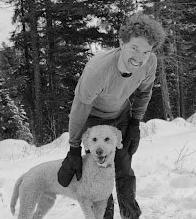
By Tayte Christensen Assistant Editor
The mathematics department grew exponentially this semester, bringing on two new professors: Assistant Professor of Mathematics Daniel Slonim ’16 and Assistant Professor of Computer Science Oliver Serang.
“I’m excited about the opportunity to not just be part of the department, but of the college and the Hillsdale life,” said Slonim, who studied probability at Purdue University and went on to do a postdoctoral research program at the University of Virginia.
Slonim graduated from Hillsdale with a double major in mathematics and philosophy, although he said mathematics was not initially part of his career path.
“I actually wanted to go into filmmaking and was thinking about screenwriting,” Slonim said.
Known as “the math kid” of his family, Slonim said he initially didn’t realize the extent to which math could go, but after taking some college classes, he came to love the subject.
“I was aware that it was possible to major in math, but at the same time, I also had the feeling that once you hit calculus 1, 2, and 3, it’s about over and there’s no more math after that,” he said. “Little did I know that there’s still an overwhelming amount of math that nobody knows, and people are still trying to figure it out all the time.”
While a student at Hillsdale, Slonim wrote for The Collegian and took several journalism classes.
“Daniel was a delight to have in class and as a Collegian writer,” Assistant Director of the Dow Journalism Program Maria Servold said.
The Grotto holds several weekly events, such as rosary on Monday and Wednesday evenings, Tuesday Mass, and Thursday Convivium, an event where students can share a home-cooked meal and hear a lecture, usually from a priest or a Hillsdale professor.
According to Hufford, the average weekly attendance for Convivium has grown from around 50 to an average of more than 80. Some Conviviums see well over 100 in attendance. The biggest event of the year was the Welcome Bonfire, with 270 in attendance at its peak.
Hufford and his wife, Shelby Hufford ’22, have run the Grotto since fall 2021.
“Since the Grotto’s inception, it’s been small, and then in the past three years, it’s been packed to the gills,” Hufford said.
The Grotto is especially crowded in the winter months when it is too cold to hold events outdoors.
Senior and Catholic Society President Charlie Miggins said he is excited about the coming expansions.
“The Grotto expansion
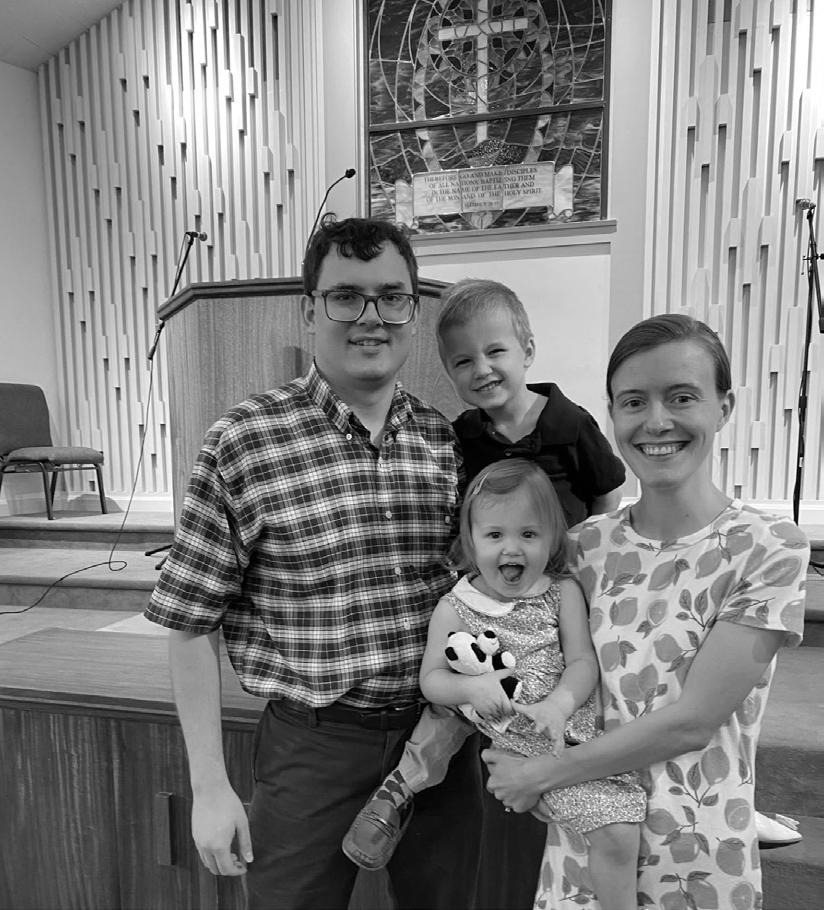
“I’m glad he’s come back to Hillsdale. This shows that journalism students can do anything — even become math professors.”
Slonim is teaching Calculus 1 and Multivariable Calculus this semester, and although he taught several courses during his time at the University of Virginia, he said his classes at Hillsdale offer him a newfound flexibility.
“I’ve never really had a chance to be totally in charge of my own Calculus 1 course.
So it’s exciting to be able to do that, but also kind of daunting,” Slonim said.
Assistant Professor of Computer Science Oliver Serang is the second faculty member to join the computer science department — a department that is growing quickly after it began three years ago, according to Chairman and Professor of Mathematics Thomas Treloar.
“Some of those computer science classes were getting up to 20 to 25 students regularly,” Treloar said. “It starts getting difficult to teach that large of a class.”
Serang will not only help decrease class sizes, but he will bring new classes to Hillsdale, potentially including a cybersecurity course in the spring semester, according to Treloar.
Serang graduated from North Carolina State University in 2006 with a degree in computer engineering and studied genetics at the University of Washington in his doctorate program.
“I got a grant from Howard Hughes Institution,” he said. “I worked for the genetics department, and then after it finished, they hired me, and I stayed on. And for three years of school, I just worked there, doing IT and research.”
After his graduate program, Serang taught at sev-
is such a joy to be a part of,” Miggins said. “Hillsdale is so on the map nationally. I’m extremely grateful for the formation I’ve received from the Catholic Society and the Grotto.”
Senior and Head of Men’s Outreach Paul Sri said he has witnessed the growth during his time at Hillsdale.
“The Grotto has been a center for my personal growth here at Hillsdale,” Sri said. “In my three years here, I’ve seen it really grow in number.”
Sri said he’s thought of the possibility of expanding the Grotto in the past.
“What Ben and Shelby do at this house is unique. There’s a reason why people keep coming back,” Sri said. “If such a small house can be so effective in drawing people together, I can’t wait to see it when it is expanded and revamped to be able to accommodate people more comfortably. God is so at work in this tiny little house.”
“If such a small house can be so effective in drawing people together, I can’t wait to see it when it is expanded and revamped to be able to accommodate people more comfortably. God is so at work in this tiny little house.”
By Tayte Christensen Assistant Editor
Christians are positioned to change culture’s perspective on sexuality, John Stonestreet, president of the Colson Center for Christian Worldview, said in a speech on Monday night.
eral universities, including Universität Bremen and Freie Universität Berlin in Germany, as well as the University of Montana. Most recently, he worked as a software engineer in Chicago, but he’d had his eye on teaching at Hillsdale for the last five years.
“It’s been on my bucket list. It’s like seeing the aurora borealis,” Serang said. “I thought it just seemed like a really nice place with good values. And I thought I would like to work there before I get older.”
This semester, Serang is teaching Algorithms and Introduction to Computer Science, and he said he is most excited to work with Hillsdale students because of the energy they bring to the classroom. He compared teaching Hillsdale students to explaining a magic trick to a rapt audience.
“It’s like hanging out with curious kids,” he said. “I think that spirit is like a big lab meeting rather than a class, when a room gets fired up like that. I like that a lot.”
According to Treloar, the two new hires will help the department offer new classes they were previously unable to.
“We have a much bigger math department, and part of it is just to see what those new hires are attracted to and sort of where we can plug them in,” Treloar said.“Whatever either of them does, just to build the programs and make them stronger is always good.”
Treloar said he is optimistic about the future of the math department with the additions of Serang and Slonim.
“I’m just excited to have them come in,” Treloar said. “We have a good department here. We have a department that really gets along, and they seem like great guys that are gonna just fold into that pretty seamlessly.”
Stonetreet’s speech, titled “The New Sexual Revolutionaries: How Christians Can Restore What’s Been Broken,” was hosted by Equip Ministries, a nondenominational ministry group on campus.
To first answer the question of sexual morality in society, Stonestreet said Christians are able to offer answers on sexual design that are upstream from thoughts on sexual morality.
According to Stonestreet, today’s culture has neglected the question of what the human body is made for: a question that must be answered if order is to be restored.
“This disconnection from purpose — to actually see the body as nothing more than a pliable canvas that we can do with whatever we want, because it has no inherent purpose, it has no inherent value other than what I assigned to — that is the new sexual ethic,” he said.
Stonestreet said this detachment, instigated by the sexual revolution of the 1960s, has continued to impact the way today’s culture views the human body.
“We’ve basically taken away all the rules, all the boundaries, all the fences, and said, ‘If you just go do whatever you want, follow your heart, you be you, do whatever you feel, you will have freedom and truth and
prosperity and all that sort of stuff,’” he said. “And guess what? It did not bring the salvation that the sexual revolutionaries promised.”
According to Stonestreet, the beliefs championed by the sexual revolution have led to a culture separated from God’s design.
“We have a culture that is actually flailing in some really profound ways,” he said. “You can see this disconnection from purpose by looking beyond sexuality into things like the suicide rate and the so-called ‘depths of despair.’”
Now, Stonestreet said the church has a calling to demonstrate proper sexual morality by acknowledging God’s sexual design and reembracing what it means for humans to be made in the image of God.
“The opportunity now is to reintroduce this concept of purpose, this fact that our bodies and ourselves and human relationships have a God-given structure and a God-given design,” he said. “If we can actually live that way, not just by not crossing the rules that God gave us, but by actually embracing that God-given design for what it means to be human.”
Stonestreet said in order to effectively shape culture, Christians should demonstrate sexual morality by recognizing that sex, marriage, and babies are inseparable.
“We want to be sexually free, not only from our behavior, but from the God-given design of the universe,” he said. “The divorce of sex, marriage and babies as a package deal that is now prevalent, not just out-
side the church, but inside the church, is a terrible witness to God’s design. There is a better way.”
Junior Jake Hamilton said that he found Stonestreet’s speech to be optimistic for Christians and the church.
“I definitely liked his applications for the church today — that we need to bring a purpose to sex and that we should re-embrace the fact that we bear the image of God, and with that, the display of the Gospel in marriage,” Hamilton said.
Although Hamilton said he found Stonestreet’s views to be insightful, he is skeptical of the outcomes Stonestreet proposed.
“I’m unsure of the likelihood of a new sexual revolution,” Hamilton said. “I completely agree with the applications Mr. Stonestreet gave for the church and I’m glad the college received that message from him.”
Junior Mikey Berry said he enjoyed Stonestreet’s talk on what he said is one of America’s most pressing issues.
“Mr. Stonestreet gave a wonderfully thorough and enlightening talk, and I was delighted to have him on campus,” he said.
Stonestreet said the first step for the new sexual revolution to take effect is to recognize what God has created the human body for.
“We know that one of the reasons that God made what he did is to reveal himself,” Stonestreet said. “So our bodies actually tell us about God, and I think this is going to be a profound part of what it means to institute a new sexual revolution.”
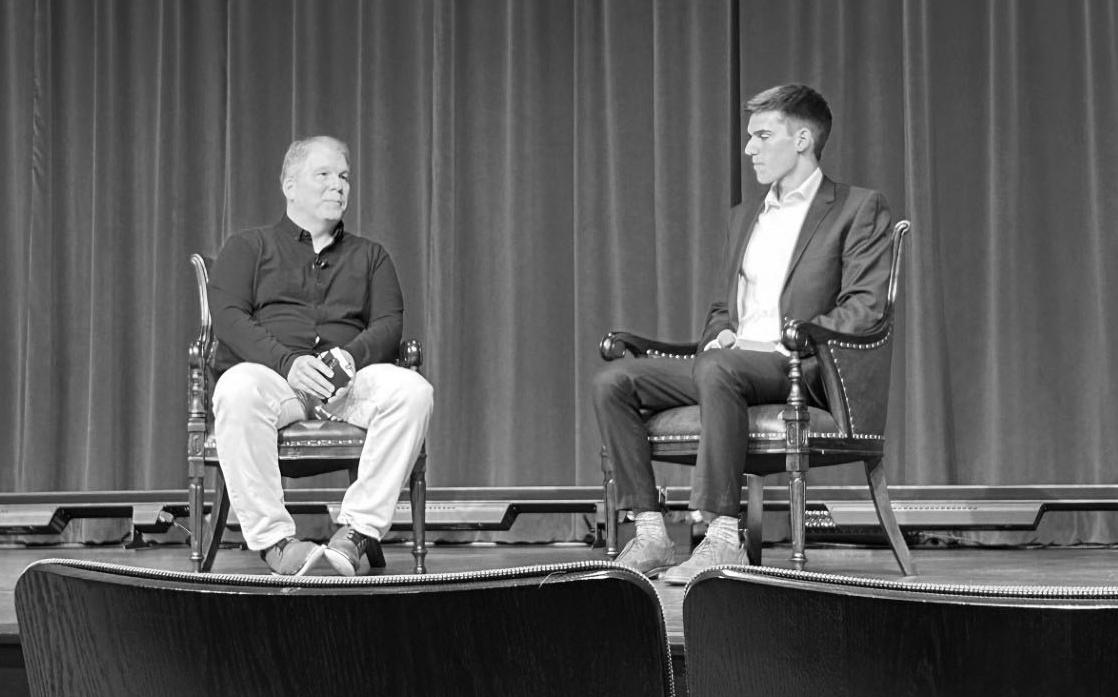
By Megan Li Assistant Editor
Hillsdale’s newest archive features letters from former presidents, artifacts from the college’s history, and political memorabilia — including more than 160 trays of pins and buttons from various election campaigns.
James E. Rogan and Charles G. Schott are the donors contributing to the collection, according to Markie Repp, library technician for Archives and Special Collections.
“A lot of pieces that are relevant to not just the White House’s history, but the nation’s history,” Repp said. “At a time when most places are wanting to erase it or tear it down, we’re here to preserve it, to make sure it lasts.”
According to Repp, every collection is the result of a generous donation to the college. Repp said donors usually ship artifacts to the college or bring them themselves.
“We have boxes upon boxes upon boxes, so it’s time consuming to go through and catalog everything,” Repp said. “What we have out is barely scratching the surface.”
Repp said the artifacts in the Heritage Room — from campaign products to presidential letters — date as far back as the time of Franklin Pierce, Grover Cleveland, and Teddy Roosevelt, with memorabilia from John F. Kennedy in the 20th century being the newest addition.
“It was very fun to do the exhibits and to see them and to touch them, and, you know, try not to freak out a little bit because I’m touching these things,” Repp said. “That was just an absolute joy to put together.”
Sophomore Ava Jolley said she was not aware of new exhibits in the Heritage Room, and she was excited by the pin collection, especially as someone who collects pins herself.
“My grandpa started that pin collection and he gave it to me when he moved, but they’re all reproductions,” Jolley said. “But it was really cool to see the legit ones since I’ve seen the reproductions and how they differ — even just materials.”
Repp said they put out various letters from Thomas Jefferson, James Monroe, and John Quincy Adams for the library’s freshman tours. She said it is a rare collection for a college as
small and rural as Hillsdale.
“The looks on their faces when we told them these were not replicas,” Repp said. “Seeing this sort of awestruck and wonder like ‘oh my goodness, we have this here.’”
Repp said she worked with her colleagues to put together the exhibit in the Hoynak Room in celebration of Hillsdale’s 180th anniversary. The Hoynak Room collection includes a 1916 baseball uniform, fraternity pins, photograph albums from the 1860s to the 1880s, portraits and watercolor paintings, and a journal from Daniel M. Graham, a former president of Hillsdale College.
“A lot of alumni are very proud of their time here at the college,” Repp said. “Their families have donated these things back to us to preserve the history.”
Archivist and Special Collections librarian Lori Curtis said she was especially struck by the story of Henry Temple McDonald, a 1960 Hillsdale graduate, and his football sweater displayed in Hoynak.
According to Curtis, McDonald was very involved on the college campus and went
on to become the president of Storer College, a historically black college in Harpers Ferry, West Virginia, where he served for 45 years.
“He was a very interesting individual,” Curtis said. “Seeing the sweater doesn’t tell you any of that.”
Curtis said she evaluates potential exhibits with the library director by seeing what artifacts are available, developing a theme, deciding what perspective to take on the exhibit, and figuring out how to display it — which requires measuring the cases and writing up descriptions.
“Things don’t happen overnight,” Curtis said. Repp encourages students that spend time in the Heritage Room to look at the artifacts and read their descriptions, especially for the letters.
“Some of them are quite personal, and it’s just a glimpse into either personal lives or the administrative lives of the people that you read about in your history books,” Repp said. “To me, there’s no better feeling than being able to see and touch history.”
By Jackson Casey Collegian Reporter
Current events this past summer have been nothing short of bizarre, said Khalil Habib, associate professor of politics.
“One of the most unbelievable things is anyone taking a shot at a former or current president,” Habib said. “And yet the media just ignored one of the biggest events in my life — a shot against a former president — and I thought that was completely unique and very revealing.”
Habib said the media quickly shifted their focus toward Vice President Kamala Harris’ entry as a contender for the Oval Office in light of President Joe Biden’s exit from the race.
“Once Biden was replaced by Kamala, they basically buried all the headlines concerning the Trump assassination attempt,” Habib said. “People now are just living their lives as if nothing happened.”
Associate Professor of Politics Kevin Slack said he recognizes the media’s actions as characteristically dishonest.
“They vociferously proclaimed Biden’s cognitive competence until Democratic Party elites decided to remove him,” Slack said. “Compared to his faltering, vacuous statements over the past two years, Biden’s debate performance went just as expected.”
Slack added that the Biden campaign’s demise was largely caused by media influence.
“Party elites and donors, looking at his falling poll numbers, decided to dispense with him, so they had the pundits turn on a dime to use the debate as news to replace him,” Slack said.
Habib said the Democratic party’s quickness to rally behind Harris is not without precedent and is a repeat of what the party did for Hillary Clinton while Bernie Sanders still had the support of many Democrats.
“Everyone knows that the machine helped put Hillary in a position to run against Trump when all the enthusiasm was for Bernie Sanders, and now you’re seeing the same thing take place with Kamala,” Habib said. “In fact, there are many Democrats who are disappointed they
didn’t get an opportunity to put forward candidates. Instead, the machine has advanced her into the candidacy.”
Assistant Professor of Politics Daniel O’Toole said he believes the Democrats’ political apparatus has worked in concert with the media to bury a problematic Biden candidacy.
“It had become apparent that Biden was too old for the job, especially after the debate,” O’Toole said. “Of course, many people could tell obviously, before that, but after the debate, they couldn’t hide it for enough people anymore.”
O’Toole said Harris brought the party a much-needed chance to start anew.
“There’s been a very deliberate media strategy to force her not to take any controversial stance, or to pretend away every radical stance that she’s taken — on health care, on the green New Deal, on the border — on all that,” he said. “So they very effectively have concealed where she actually is politically and have made it seem like that doesn’t matter — she’s so fresh and new.”
O’Toole also said that the media appears to have used similar strategies against Sen. J.D. Vance, the Republican nominee for vice president.
“They’ve highlighted every statement that Vance makes, taking it out of context, to make him sound — by modern, 21st century standards — to be ‘weird,’ even though the reality is, if you actually listen to the guy speak, he’s highly intelligent, thoughtful, and makes developed arguments,”
O’Toole said. “I just fear that the incredible power of the media narrative is politically decisive.”
Slack said that the reasons why she is a step up from Biden are clear.
“Despite her inanity, stupidity, and fake Southern accent, Harris can remember her husband’s name and venture across a stage without help from secret service,”
Slack said. “A vote for Harris, just like a vote for Biden, is not for the candidate but for the oligarchs who will make the real decisions.”
Slack added that Harris, while still more capable at a basic level, has many pitfalls of her own.
“First, Biden and Harris’s
administration was a genuine disaster on immigration, foreign policy, and economics, which is why she has had to flip-flop on key issues. Second, Harris is truly incompetent — she literally slept her way into political office — and there is a decent chance that she will embarrass herself the way she has for four years,” he said. “It is no accident that ‘Tampon’ Tim Walz, and not Josh Shapiro or Gretchen Whitmer, is her running mate: the latter two do not want any part of this dumpster fire.”
More recently this cycle, independent candidate Robert F. Kennedy Jr. dropped out of the race and endorsed Trump. Habib said while the endorsement itself might not greatly affect the election, it still carries weight.
“It signifies that many reasonable centrists have left the Democratic Party,” Habib said. “Don’t forget — Tulsi Gabbard, who was always an independent, is now fully supporting Trump and has switched to the Republican Party. So has Robert Kennedy. I think that’s more significant. Endorsements really don’t add that much.”
Habib added that Kennedy’s candidacy might still sway the election in certain states.
“What also has more significant traction is RFK pulling his name out of certain states to not take votes from Trump,” Habib said. “Democrats in those states now are trying to force RFK to keep his name in there even though he no longer wants to run. If he wasn’t a threat, they wouldn’t have attempted that.”
O’Toole said that Republicans must tap into their voting base by campaigning on Trump’s hallmark issues in order to energize voters.
“I think the key is getting out working-class, middle-class voters — including white voters who are often neglected — and focusing on the 2016 issues,” he said. “Trade, the border, crime, a non-interventionist foreign policy, and then the economy and inflation. Those core issues are what matter most and are most likely to bring him voters.”
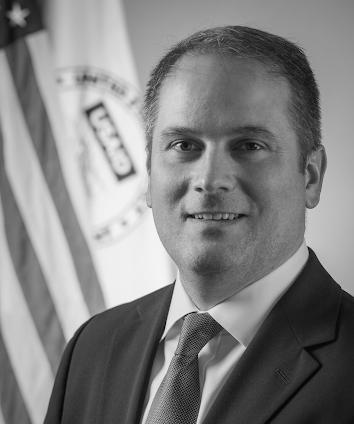
By Sarah Katherine Sisk Senior Reporter
While serving as an appointee in the Trump administration, Mark Moyar observed flagrant corruption in the federal government, he writes in his new book, “Masters of Corruption: How the Federal Bureaucracy Sabotaged the Trump Presidency.”
Moyar, the William P. Harris chair of military history, will discuss his experiences Sept. 13 at 4 p.m. in Plaster Auditorium with a reception to follow at 5:30 p.m.
While serving as director of civilian-military affairs for the U.S. Agency for International Development, Moyar said he identified evidence of fraud amongst several senior career bureaucrats and reported it.
In retaliation, the bureaucrats corroborated to have a special operations general falsely accuse Moyar of revealing classified information, according to “Masters of Corruption,” which was published in May by Encounter Books.
“Appointees who were committed to implementing the policies of the Trump administration encountered massive resistance from the career bureaucracy and, even more troublingly, from political appointees who joined forces with bureaucrats for self-serving reasons,” Moyar said.
“The book recounts the war between the Trump appointees who sought to drain the swamp and the career bureaucrats who are the preemi-
nent creatures of the swamp.”
Moyar said he hoped to provide a guide for Republicans who will have to work in hostile bureaucracies, but wrote the book with all Americans in mind.
“In a country committed to ‘government of the people, by the people, and for the people,’ every citizen should be concerned by the usurpation of power by a corrupt administrative state,” Moyar said.
Chairman and Associate Professor of History Korey D. Maas said the lecture will focus on Moyar’s own experiences in the Trump administration.
“He blew the whistle on what he believed to be serious examples of waste, fraud, and other wrongdoing in the Agency,” Maas said.
Instead of receiving standard whistleblower protection from the Obama-appointed inspector general, his security clearance was suspended, and he was pressured to resign according to Maas.
Moyar said he will cover key events in the book, primarily those that may help students make good decisions in their own lives, and touch on broader themes of politics, ethics, religion, leadership, education, and resilience.
“Partisan politics is often a dirty business, and service in government is often a thankless task, so the book explains why people of virtue should participate in politics and government rather than turning away from them,” Moyar said.
By Elijah Guevara Collegian Freelancer
Alumnus Daniel Silliman ’06 released his second book, a religious biography of Richard Nixon, in August.
“One Lost Soul: Richard Nixon’s Search for Salvation” examines the ex-president’s life, political career, and public fall from grace as a spiritual struggle, according to the book’s introduction.
The book released on Aug. 8, the day before the 50th anniversary of Nixon’s resignation amid the Watergate scandal.
“Very few religious biographies are about ‘bad people,’ and very few religious biographies are sort of explaining someone’s failures in terms of theology, in terms of faith,” Silliman said. “That’s what I tried to do. That’s what makes it a little different.”
Silliman, a journalist, historian, and news editor for the evangelical magazine Christianity Today, said the more he read about Nixon’s life from political and historical perspectives, the more he perceived a deeper, religious story to be told.
“Nixon did have this deep,
spiritual turmoil and this sort of theological fight in his life and in his heart,” Silliman said.
“There’s a lot of his successes — which there were a lot of successes — and a lot of failures, which were quite wellknown, that really make more sense if you understand that struggle going on in his heart.”
While at Hillsdale, Silliman studied philosophy and wrote for The Collegian. After graduating, he worked as a crime reporter for a local community newspaper outside of Atlanta, Georgia, where he reported on 100 murders.
Silliman earned master’s and doctoral degrees in American Studies from Heidelberg University in Germany and taught at various universities before becoming the news editor for Christianity Today, an evangelical magazine founded by Billy Graham, a longtime friend of Richard Nixon.
Executive director of media outreach and public relations Emily Davis ’05, who shared philosophy classes with Silliman and also wrote for the Collegian, said he chose well to become a reporter after college.
“Daniel was a talented writ-
er, was engaged on subjects that interested him, and had a doggedness in his questioning that has served him well as a journalist,” Davis said in an email to the Collegian.
Professor of philosophy and culture Peter Blum said he enjoyed having Silliman in his classes.
“He was always the person I could trust had looked at the stuff we were supposed to have looked at for any particular day,” Blum said. “He was able to think deeply about it, and he raised a lot of really good questions.”
Silliman credited his Hillsdale professors with encouraging him not to take shortcuts in order to reach the right conclusions.
“You needed to do all the work,” Silliman said. “You needed to be humble in the face of history, in the face of other people who have different experiences, different thoughts than you, and you have to work through it all.”
By reading biographies and political histories of Nixon, Silliman said he would come across hints of religious issues, which he found to be lacking from other biographies.
“As I kept reading about Nixon, I kept thinking there’s a religious story that needs to be told here that would really deepen our understanding of what was happening with Richard Nixon,” Silliman said.
Silliman said another factor that drew him to write about Nixon was that he recognized himself in Nixon.
“He’s kind of a weird person and has some bad and self-destructive instincts,” Silliman said. “As much as I didn’t like it, I just sort of would read it and think, ‘OK, I do that. I get how that feels. I understand that kind of wounded way of walking through the world.’”
Silliman said he hopes first to give readers a fuller understanding of Nixon through his biography, but that he also hopes to convey the importance of empathy towards people who are easy to judge like the ex-president.
“If you see Richard Nixon as a failure, as a tragedy, as a bad person, you’re not wrong, but also thinking about his struggles and his inner turmoil will actually help you more and give you more insight than that kind of judgment gives
By Elizabeth Putlock Collegian Freelancer
The Hillsdale K-12 Education Office recently expanded its staff to support their member and candidate schools, according to Kathleen O’Toole, assistant provost for K-12 education.
“As the number of schools grows, our office must grow too, so that we can know them well and continue to serve them with excellence,” O’Toole said.
Seven new hires fill both new and old roles including assistant director of board governance, assistant director of curriculum, and director of communications.
According to O’Toole, the K-12 Education Office seeks to provide a classical education in the liberal arts to new or aspiring schools. With 30 member schools in 17 states, the office supports and guides initiatives to start classical schools around the country.
“We work very closely with these schools, and they are locally operated, which we think is an important element,” O’Toole said. “Our relationship with them is purely voluntary, and we’re bound together by our common pursuit of the same mission.”
Assistant Director of School Leadership Development Colin Mullaney joined the team in July. Previously, he founded a classical school in Colorado Springs, Colorado. Mullaney said he visited Hillsdale Academy to learn about its curriculum, which then inspired the growth of his own school.
“The engagement of the students, the depth of the learning, the coherence of the curriculum, and really the end goal of what the classical education is all about — supporting young human beings in human flourishing and helping them to love what is good, true and beautiful — just inspired us,” Mullaney said.
Mullaney said he kept up the connection with O’Toole after she came to visit his school.
“We support our member schools by visiting them, working alongside their teachers and headmasters and board members,” O’Toole said. “They come to the college, too. This is very human work, possibly only within a community of friends working together.”
you,” Silliman said. Blum said what interests him in reading the book is Silliman’s sensitivity to writing about complicated figures by neither idealizing nor vilifying them.
“I think Daniel knew from the beginning if you’re tempted to do one or the other of those things, you’re gonna cover over probably a lot that’s more complicated,” Blum said. “And I think that’s exactly what he’s doing with Nixon.”
Silliman said that approaching Nixon as a human, with deep spiritual needs and acute spiritual struggles, is good history that we can use to better understand his story and ourselves in the context of his lifelong struggle.
“People are shaped by their spiritual longings,” Silliman said. “They are shaped by their interactions with God and interactions with scriptures and interactions with the church, and those things make people who they are. Everyone who wants to understand a little bit about history would do well to pay attention to some of those things.”
Lyna Heaton, the new teacher support lead, experienced these relationships firsthand when the Hillsdale K-12 team visited her affiliated school where she taught.
“Instead of criticism, they focused on how they could assist me, showing a genuine warmth and commitment that left a lasting impression,” Heaton said. “Their supportive approach is something I carry with me, and I am eager to bring that same level of encouragement to my new role.”
Heaton’s role involves building communities of teachers and connecting them with a national network of classical educators.
The K-12 Education Office also provides free course curricula to private and public K-12 schools that want to use it, according to O’Toole.
Mullaney said K-12 Education team members are excited to see the effect their developments might have on education across the country.
“I think with the growth of the office, we are in a position to really have a quantum leap in the impact we have with schools,” Mullaney said.
opinion of the Collegian editorial staff
“Where were you when you first heard that planes hit the World Trade Center?”
Other Americans can answer that question. They remember what happens when the forces that seek our destruction reach our shores.
But almost every undergraduate student at Hillsdale is part of a new generation of Americans who cannot remember. We should still join those who

By Caroline Kurt Opinions Editor
Within a span of one week last year, all of my close female friends got dumped, stood up, or rejected.
“How could he?” one friend would ask, and we would all nod our heads in sympathy. Boys are dense at the best, malicious at the worst (or so it seemed). We hugged each other and promised to swear off men — my boyfriend the exception — for a time.
We laugh about it now, but that week almost turned us into man-haters, at least for a semester or two. Thank God it didn’t.
We’re back into the swing of classes, lectures, parties, and — yes — heartbreak. Something about tossing several hundred young men and women together into a small college campus seems only to amplify the inevitable tensions between the sexes. Add stress, alcohol, immaturity, and — voilà! — things are bound to go badly from time to time.
In the culture we live in, bitterness between the sexes seems the norm rather than the exception. Singers like Olivia Rodrigo and Taylor Swift build entire careers off of angry, angsty music lamenting some hurt or another. Researchers and journalists have documented the trend of Gen Z “opting out” of common precursors to true romance. According to a 2023 survey by the Survey Center on American Life, 44% of Gen Z men report never being in a romantic relationship during their teenage years. That’s more than twice the number as their Baby Boomer grandparents.
Breakup music has its place, but we can’t remain angry or opt out of building healthy relationships.
We have the opportunity here when wrongs and misunderstandings inevitably arise to maintain a sporting spirit and grow from the experience. We’re better together than apart.
We can’t ignore the tensions that will always exist between men and women: in the romantic sphere, but also personally and profes-

sionally. Men and women see the world in different ways. Our strengths, insights, motivations, and vulnerabilities are — broadly speaking — pretty different.
Even here, in a school with a largely healthy dating culture, you’ve probably experienced some kind of grievance at the hands of the opposite sex.
The easiest thing to do is to hold that grudge, generalize it, and assume men and women are fundamentally at odds with one another.
The harder task is to seek to understand the others’ point of view, extend them forgiveness, and seek to repair and maintain strong bonds of friendship and romance between the sexes.
Because even in this fallen world where so much goes awry, men and women need each other — to procreate, certainly, but also to see.
And together, we can wound each other in ways not possible if we keep our distance, but we can also heighten each other’s joys, successes, and ambitions. We can hold each other accountable. Iron sharpens iron, and good men and women together make each other all the better — more compassionate, more insightful, more humble.
It’s through those male-female tensions, not in spite of them, that we learn to be better.
The best part is, it’s more fun this way. If we can learn to laugh at our blind spots and follies, and take some things lightly, the world’s an easier place to live in.
Breakup week was saved by humor, and gradually we came to recognize the good intentions of the men in question. Bitterness faded, and what remained were stronger friendships and a renewed appreciation of the men in our lives.
Caroline Kurt is a junior studying English.
every year reflect on what those horrifying and tragic moments meant.
What is there to remember?
Remember there are still heroes among us. More than 340 firefighters died that day — some of those who didn’t are still serving.
Remember that there has not been another 9/11 since then. We still ride airplanes — and we complain if they are delayed.
Remember, though, that there are still those who want to end our way of life. There are still people who chant “Death to America” — some of them handed out pamphlets with that message at the University of Michigan last spring. The same hatred for us that motivated the hijackers still motivates many of our adversaries today. This threat remains.
Hillsdale teaches young people about things they do not remember but should preserve. Even for people who cannot remember it, 9/11 should remain the most tangible reminder that those blessings are always under threat. We may be too young to remember — this does not mean we should forget.
By James Joski Collegian Freelancer
Whether you see Kamala Harris as a deep state puppet or the savior of the Democratic party, you can’t deny that her PR team has been working overtime.
In the weeks since her ascension to the position of Democratic presidential nominee, Harris has managed to convert Biden’s 3.2 point polling deficit as of July 21 to a lead of 2.7 points as of Sept. 10, according to a poll by FiveThirtyEight. While polls may not always be precise (even Pew Research has admitted to their shortcomings), they can still be good ways to spot momentum. Even conservatives have to acknowledge the Harris campaign got a few things right.
Kevin Madden, former senior adviser to Mitt Romney’s 2008 and 2012 presidential campaign and current CNN commentator, talked about the need for careful management of a campaign’s public image.
“The goal is to control the narrative as much as possible,” Madden said.
This common, bipartisan political strategy has become a core aspect of the Harris campaign. Independent news group America Uncovered pointed out that she has only had a single media interview since her assumption of the role of Democratic presidential nominee, whereas Trump has had four in that time. Harris is better able to protect her fragile image and control the narrative by limiting her media exposure.
In the meantime, Harris has
consistently discussed vague optimistic talking points, proclaiming herself a “new way forward.” After having dealt with
policy vessel, Ms. Harris has allowed various constituencies within the Democratic Party to project their hopes and prior-
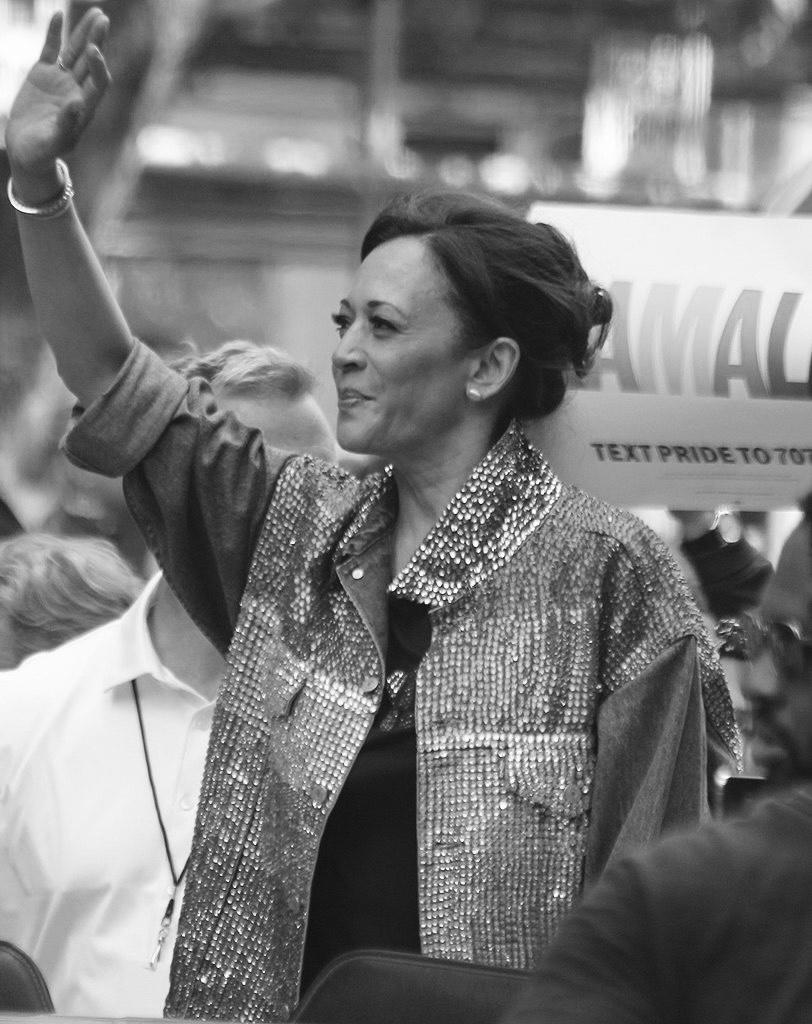
months of walking back Biden’s statements, it seems the Democratic party has learned to make indefinite promises. Interestingly, Harris’s slate of undefined political promises has become a feature rather than a bug of her party’s electoral machinery.
Anthony Zurcher, a writer for the BBC, described the strategy in his BBC article titled,
“Kamala Harris [sic] campaign is light on policy - but that’s helped her transform the race.”
“By largely being an empty
ities onto her,” Zurcher writes.
Whether that’s a compliment or an insult, it’s working. By limiting Harris’s public discourse, her campaign has turned her into the perfect catch-all to galvanize unrelated and often contrary political groups.
Unfortunately for her hopeful support base, Harris’s campaign has been a classic lesson in rebranding an old product rather than selling a new one.
In Harris’s one interview with CNN’s Dana Bash last
month, she affirmed her intent to uphold many of Biden’s policies — ironically often themselves watered down adaptations of Trump’s policies — including those related to economics, Israeli-Palestinian relations, border policy, and the continuation of fracking. The New York Times went so far as to call Harris a “better salesperson for Mr. Biden’s accomplishments and defender of his record than he ever was.” How this reverence for the president’s widely reviled and divisive policies will mesh with a united “new way forward” is still open to question.
This incongruity between perception and policy should come as a wake-up call to voters across the political spectrum to cast aside informational complacency in their consumption of news. We cannot allow ourselves to be swayed by superficial campaigns of “Joy” or other diversionary strategies. We must instead commit to rigorously questioning our leaders, no matter how much we despise the opposition or wish for our own candidate’s victory. If we do not seek to expose a politician’s nature before casting our vote, we will have imprisoned ourselves voluntarily to their true intentions when they no longer need our support. Leaders ought to be held accountable before and after votes are cast. Hopefully, the PR teams get paid overtime before we wash their hard work away.
James Joski is a freshman studying the liberal arts.
By Skye Graham Collegian Reporter
The hysteria around Project 2025 among the Democratic Party and the media is a ploy for the uninformed voter.
“It’s a plan to turn Donald Trump into a dictator,” said Michigan Senator Mallory McMorrow at the Democratic National Convention.
Ironically, President Trump has disavowed Project 2025 on numerous occasions.
“They came up with some ideas, I guess, some good, some bad,” said Trump in his debate with Vice President Kamala Harris. “But it makes no difference. I have nothing to do. I’m an open book.”
Project 2025 is the Heritage Foundation’s plan of action for the next Republican administration. The organization has created similar plans in previous years, so Project 2025 is nothing out of the ordinary.
What is out of the ordinary, however, is the hysteria surrounding it.
Democrats are relying on the fact that most voters won’t read the more than 900 page document or know that Trump has disavowed the plan.
“Project 2025’s plan to eliminate public schools has already started,” reads a Time Magazine headline from July.
But Project 2025 doesn’t call for the elimination of public education. Rather, it calls for school choice policies, which would allow families to send their children to private schools through a school voucher program.
Trump’s own proposal for his administration, Agenda 47, likewise supports strengthening school choice. It makes no mention of eliminating public schools or cutting funding to educational institutions.
Harris has told voters to read Project 2025, but that
just betrays the fact that she herself hasn’t read it — or is lying about its contents.
“When you read it, you will see Donald Trump intends to cut Social Security and Medicare,” said Harris at a July 23 rally in Wisconsin.
When Harris urges voters to read Project 2025, it’s an empty statement. If voters took her up on that suggestion, they would find that such a proposal exists nowhere in the document. In fact, if voters took a look at President Trump’s campaign website, they would find that he intends to protect Social Security.
“Fight for and protect Social Security and Medicare with no cuts, including no changes to the retirement age,” reads one of the Agenda 47 proposals.
If the Harris campaign truly wanted to show the dangers a second Trump term would pose, they could simply point
to his list of policies and explain why they aren’t effective. The hysteria on the part of Harris and the Democrats can be chalked up to nothing more than a cynical political strategy. If you would like to truly understand President Trump and the GOP’s vision for America, read the agenda outlined on his website. Listen to his speeches at rallies. Watch his interviews and town halls. Rather than sifting through the media coverage of a document that’s almost 1,000 pages long, see for yourself what President Trump believes.
Graham is a sophomore studying history.
By Charlotte Knobloch Collegian Freelancer
Robert F. Kennedy Jr.’s withdrawal from the race has proven that even an American elite cannot overcome the two-party system. The media has continuously painted independent runners-up as the recipients of wasted votes. Citizens often label themselves as Democrat or Republican, even if they do not fully agree with either party. And therein lies the problem. The country knows what every independent voter must realize deep down: Outside candidates never win.
We haven’t had a candidate who wasn’t either Republican or Democrat in the White House since Millard Filmore in 1883. Even Teddy Roosevelt, a very popular president, lost re-election when he ran for a third party. Americans must examine the effects a two-party system has on our country and candidates.
RFK Jr.’s recent endorsement of Republican candidate Donald Trump symbolizes a loss of hope, the sight of a candidate settling for less than he dreamed.
Kennedy’s two pinned posts on Instagram declare the former Kennedy campaign’s goal. The top post is captioned simply, “UNITE AMERICA.” The video is a montage of Robert F. Kennedy’s speeches contrasted with clips of Trump and Kamala Harris. The second post, from Dec. 8, 2023, says that Kennedy is on track to break the two-party system and become the first independent president since George Washington. He was polling strongly and gathering supporters from both ends of the spectrum. So what went wrong?
When a party is attempting to get a candidate elected, they are trying to sell a product. For example, Tim Walz is being sold as a down-to-earth Midwesterner who looks out for the people. People buy into an image and, ultimately, that is who becomes elected. Since RFK Jr. didn’t have a party to back him up, he had to sell himself.
Despite his performance at the polls, the media has
used a variety of tactics to portray a certain image of RFK Jr. At first, they ignored him. In June 2024, CNN would not allow him to debate with Trump and Biden. Mainstream media has more recently turned to gruesome smearing and storytelling to discredit RFK Jr.
The attacks began during COVID-19, when the media labeled RFK Jr. as a conspiracy theorist and spreader of misinformation due to his vaccine stance. Anyone who is familiar with RFK Jr. has probably heard him talk about recovering from a 14-year-addiction to heroin that started from family trials. Instead of celebrating someone who has worked incredibly hard to overcome hardship and addiction, the media sharpened their knives. The Atlantic published “RFK Jr. Was My Drug Dealer,” a scathing criticism of RFK Jr. that questions his ability to prosecute drug dealers, given that he allegedly sold cocaine in college.
Despite the odds, Team Kennedy still campaigned vigorously, seeking to use a grassroots campaign to their benefit. But did the same independent, hippie, grassroots effort that attracted voters also contribute to his downfall? Even though RFK Jr.’s humility set him apart, it also helped usher him into a lost corner of the internet.
As someone who was seriously considering voting for RFK Jr. and stands behind his political positions, I grieve for the loss of the campaign and the loss of a choice. The pursuit of truth requires the knowledge of truth — and that means individual people doing independent research. The media cannot be trusted to give us a complete or a fair view, especially when it comes to third party candidates.
Charlotte Knobloch is a freshman studying the liberal arts.
By Beth Crawford Senior Reporter
Hillsdale should celebrate Constitution Day.
Why it doesn’t already, nobody knows. It would be in the College’s best interest to do so. After all, the Constitution is almost synonymous with Hillsdale’s identity and brand as an educational institution.
Out at the Washington, D.C., campus, Hillsdale has a swanky two-day celebration dedicated to the Constitution, complete with dinners, speeches, panels, and debates. George Washington Fellows get flown out to D.C. to staff the event. But where is its equivalent on Hillsdale’s main campus? As far as I can see, there isn’t one.
As it stands, Hillsdale doesn’t take either Constitution or Labor Day off. Some say that Hillsdale has school on Labor Day to prevent freshman homesickness. Others say that Hillsdale doesn’t take the day off because
it smells of Communism.
But none of the objections to Labor Day apply to Constitution Day. Take, for instance, the argument that freshmen will get homesick if they are given a long weekend so early in the semester. Celebrating Constitution Day avoids that question altogether — it falls a few weeks later in the semester, so there’s less of an excuse to go home.
Having a day off generally means taking a day from Christmas break or summer break. But would most people care if their semester is a day longer? My suspicion is no, probably not.
Christmas and summer breaks are long. And by the end of them — whether it’s because they worked a tedious job, had a helter-skelter internship, or struggled with complicated family dynamics — most students are itching to get back to school.
And a small break after the first month of school would be
a welcome relief before the upcoming pressures of homecoming and midterms.
Constitution Day dodges the dubious origins of Labor Day. It is true that Labor Day is a celebration of the industrialized worker’s contribution to society, and, whether rightly or wrongly, it’s something that makes some people’s skin crawl at Hillsdale.
But what if we celebrated something that is not an insignificant part of our experience, such as the system of government that our founders enshrined in our Constitution?
Okay, maybe the Constitution doesn’t give you chills. But my point stands — what if we celebrated something that is integral to both our nation and experiences as students at Hillsdale College?
The good Lord only knows that we love to talk about the Constitution at Hillsdale. It’s included in the Core curriculum, promulgated in little pamphlets, and featured prominent-
ly as part of Hillsdale’s Online Courses. In some ways, talking about the Constitution here can almost feel like you’re contributing to a well-worn cliche — one that we’re all familiar with and that causes many to roll their eyes.
But maybe if we actually celebrated the day — made it a day to rest, socialize, read — it would feel less so. All our talk would more meaningful if we could actually enjoy a day celebrating the freedoms it gives us. It might just be another day for most Americans, but Constitution Day would actually have some importance for Hillsdale students.
Maybe having an extra day off doesn’t seem like much. But in the case of Constitution Day, it means staying true to what we claim to cherish here at Hillsdale. And we would all be thankful for it.
Beth Crawford is a senior studying politics.
By Anna Leman Collegian Freelancer
Call me a fundie, but everybody should learn how to swing dance.
Partner dancing is slowly fading from the American dance scene. What once occupied the pastime of thousands of American youths has transformed into party line dances, solo freestyling, and the latest TikTok craze. Not that backing-up to “Cha-Cha Slide” or learning the steps to “Texas Hold ‘Em” are bad, but partner dancing should return to the list of must-know dances.
Swing dancing is the perfect style to bring such dancing back. Its simple steps, intuitive turns, and basic dips make it quick and easy to learn. Give it an hour, and you can be triple-stepping across the dance floor with your partner.
Not only is it simple to learn, but the style is very forgiving. Unlike more formal ballroom dances, swing has an easy-going, lighthearted style. It is the jazz of dance and, as the famous jazz musician Miles Davis said, “Once is a mistake, twice is jazz.” A mistimed step, awkward handhold, or misread cue go unnoticed as the jazzy quirks that make swing what it is.
The flexibility that hides mistakes also invites creativity. The lead can create hundreds of combos by mixing and stacking inside spins, frat boy turns, and the pretzel. The various dips, tricks, and turns provide fodder for improvisation, risk taking, and pattern building. There’s always something new to discover, something fun to learn — no strict routine or formal training required.
Moreover, the slightest variation of steps makes most pop and country songs swingable. Although traditionally danced to Big Band Jazz, the numerous styles within the swing world — Lindy Hop, West Coast, East Coast, Hustle, Boogie, Twostep, and country swing — make swing applicable to most popular songs. From Michael Jackson to Morgan Wallen to Taylor Swift, swing can dance to them all.
Swing’s versatility extends beyond musical genres. Weddings, proms, and jazz concerts still provide dance floors for swing dancers to show off their moves. Knowing the basics goes a long way to impress friends and family, not to mention your sweetheart.
Speaking of weddings and sweethearts, many students mistake swing for a dating pro-
gram. The guy dances with the girl, they fall in love, and next thing you know they’re married juniors and she’s dropping out of school to raise their newborn.
Swing tradition dictates that a man leads a woman through the dance but dancing with a girl doesn’t make her your wife. Rather, swing provides a structure that encourages courteous interaction, casual conversation, and lighthearted fun with the opposite sex.
Beyond wholesome social interactions, swing also teaches valuable communication skills that modern solo dancing lacks.
On the dance floor, the lead is responsible for directing the follow. His hand gestures, visual cues, and words must clearly communicate to his follow the moves he wants to execute. Not only does this require him to be clear and decisive, but it forces him to adapt his communication style to his follow.
Every follow has her own quirks and flaws. Some grip hands too tight. Some need a firm hand to prevent back-leading. Some are too rigid to move fluidly. Learning how to adjust to his follow’s dancing personality teaches the lead flexibility, empathy, and clear communication.
In return, the follow is re-
sponsible for following the lead’s direction. This requires sensitivity and attentiveness to his physical and verbal cues. She must adapt herself to the patterns and leading style of her partner. Whether he is a strong lead that loves to dip or a gentle guide that favors spins, she must move to the tone that he sets. Being a follow fosters compatibility, responsiveness, and adaptability.
The lead-follow relationship is a game of call and response, of give and take. The two must work together and use their strengths of adaptability and communication to create something beautiful. The skills of partner dancing translate into everyday life. Group projects, business partnerships, and marriage dynamics all mirror the lead-follow relationship and require clear communication, empathy, adaptability, and responsiveness. The dance floor is a fun, simple way to practice those valuable skills.
Anna Leman is a senior studying politics.
By Catherine Maxwell Assistant Editor
As one of the 80% of Hillsdale students who are from outside Michigan, I’m grateful that Hillsdale has let me store my belongings on campus in the past. I understand the lack of space in dorms (I lived in Olds Residence, after all), but the administration should have tried compromising with students before nixing storage. Unlike many other colleges, Hillsdale has previously assisted students by letting them store their belongings on campus over the summer, according to the deans. With the sudden change to the storage policy, many will scramble to figure out how they will move home in the spring. For future decisions, incrementally changing the policy and clearly explaining the problem will help students adjust. According to the deans, the previous storage policy was becoming unsustainable. The dorms didn’t have enough storage to accommodate students traveling long distances, and the housekeeping staff struggled to clean rooms stuffed with boxes.
“We should have done this a long time ago,” said Dean of Men Aaron Petersen.
The new policy lets students store one TV and one mini fridge in the dorm storage rooms. The administration suggested renting a storage unit and Petersen said the deans hoped students would split the cost.
Although there are storage facilities near Hillsdale College, they cause logistical problems for students.
Lake Wilson Storage is the closest storage facility to Hillsdale College. The cheapest units at its Monroe Street location, near the Handmade sandwich shop, are $55 per month, while the most expensive cost $75. Splitting the expense three or four ways makes the price more manageable (at $15–$25 per month), but sharing a unit could be impractical.
According to its website, Lake Wilson requires renters to provide their own locks. Unless students duplicate keys (which will be a hassle during the end of the school year), they’ll have to coordinate move-in schedules to access their unit. Given the number of students who move in early
— such as resident assistants, orientation guides, athletes, and Collegiate Scholars — it’s likely the unit won’t be emptied at one time.
If students don’t have cars, they will have to find a friend to help ferry their belongings to Monroe Street, assuming it has available units. The next closest facility, Lake Storage Company, is 2.5 miles away. With the influx of students needing units, it’s probable that some will have to travel outside Hillsdale to find something available, which adds stress to those without vehicles.
Drastically changing the policy at the start of the school year makes it unnecessarily difficult for students to manage their belongings. Telling students about the problem in August doesn’t magically reduce the belongings they’ll take home in May. Students who packed for summer storage months ago tried to maximize the belongings they left behind, a strategy which makes them unprepared for the new policy.
Students who have gotten used to leaving bins on campus will be forced to rent a locker or throw items away.
It’s unlikely students will find enough space in their cars to bring their bins home — especially since most drive sedans instead of SUVs. Students who fly face the same problem.
The new policy also ignores students who move themselves in. Some of my friends drive themselves to and from school and don’t have space in their cars for all their belongings. Others carpool and might not be able to drive their bins home. Some bring parents and siblings to help them move in, but that’s not possible for everyone, especially families with lots of children. Forcing families to balance children with moving chaos or find childcare ignores the sacrifices they’ve already made for their students.
For some, packing lighter might be a solution. But students have to bring summer, fall, and winter wardrobes for Michigan weather. Even if they cut back on clothes, students still bring textbooks, furniture, instruments, and small appliances. “Packing light” shouldn’t mean making dorm life unbearable.
If the administration wants to keep students in dorms
instead of giving more permissions to live off campus, it should be prepared to face the consequences instead of off-loading them on students.
According to Petersen, students abused the old storage policy. That may be true, but communication about the old policy was never clear.
In my previous two years at Hillsdale, storage rules varied from dorm to dorm. Olds let women who lived more than six hours away store two 30-gallon bins and said nothing about TVs or mini fridges. Most women stored a fridge anyway. Benzing Residence let women who lived over eight hours away store two bins of unspecified size and a mini fridge.
The lack of consistent rules created confusion, and students will now benefit from a blanket standard. But rather than effectively nixing the policy, the administration should have tried a compromise first.
A compromise policy could have informed students that storage space was running low and that the administration was reevaluating it. Limiting storage to one bin and one mini fridge would prepare
students to pack less or look into other options. If after the new policy storage space was still a problem, the administration could limit all students to a fridge and a TV. Justification for the distance students are required to live from campus could also placate students. Vehicle space doesn’t multiply if a student lives 7.5 hours away instead of eight. If the numbers show that restricting the distance to eight hours will help with space, students should be told instead of wondering why eight is suddenly the magic number.
In the end, students are responsible for what they bring to campus. We’ll either share a unit or find a way to move everything home. Next time, letting students in on the process will make everyone happier and the transition smoother.
Catherine Maxwell is a junior studying history.
By Catherine Maxwell Assistant Editor
The Hillsdale County District Court has been releasing about five to 10 inmates per month from the county jail for the past two years, and officials say it could take years to expand the overcrowded facility.
Although the jail’s official capacity is 67 inmates, overcrowding has forced it to hold an average 75 inmates on any given day, according to Capt. Jason Stiverson, the jail administrator. On Sept. 5, the jail housed 85 inmates. The county adds portable bunks and uses a multipurpose room for extra space.
But the Sheriff’s Office, which manages the jail, still repeatedly asks the district court to release inmates, said District Judge Megan Stiverson.
“Every week, I have to decide who poses the least threat to the public safety in Hillsdale County,” she said. “There is no set of rules.”
Stiverson said in an email that the court and the jail have not tracked the number of inmates it releases early, but estimated that she has released about five to 10 inmates early per month for the past two years. The sentenced are put on probation, and the unsentenced are released on bond.
She said both the court and the jail will start tracking early releases moving forward.
Mark Wiley, chairman of the Hillsdale County Board of Commissioners, said although the commissioners know the jail needs to be expanded, relocating the Hillsdale County District Court is their first priority.
“We have more needs than we have money right now, and the jail is definitely on our radar,” Wiley said. “I would like to think that within the next three years we can start addressing the need at the jail.”
Releasing inmates early
When the jail reaches overcapacity, the Hillsdale County Sheriff’s Office asks the district court to release inmates, Jason Stiverson said. Megan Stiverson said she is usually able to return the jail’s population to the 70s.
Megan Stiverson said when deciding who to release she considers factors such as past criminal history, likelihood of appearing in court, history of drug use, and history of violent crime. She releases financial and property criminals first but said the kind of inmates she releases varies depending on who the jail is lodging.
“I think most of the individuals I’m releasing are probably serving sentences because they violated their probation,” she said.
Crimes against a person, it’s harder to legitimize.”
Megan Stiverson said during the interview she had one case where she might have to release a domestic violence offender.
Her grant-funded victim services coordinator is investigating to see if the victim has an opinion on a potential early release.
“I don’t want to release him
County, a full-time, grant-funded domestic violence court probation officer, and a part-time, grant-funded veterans court probation officer. The full-time officers monitor approximately 100 probationers each.
Diagnosing the problem
Although the sheriff’s office has dealt with occasional overcrowding, it has become a consistent problem for the past two
Megan Stiverson said some of the overcrowding problems were caused by House Bill 5396 of 2020, which took effect in 2021. The bill increased the number of crimes that went straight to probation with the intent to decrease the number of inmates in jail. But the bill also housed more felony offenders in local jails instead of state correctional facilities.
“Every week, I have to decide who poses the least threat to the public safety in Hillsdale County. There is no set of rules.”
She said she most often sentences people for use of narcotics, domestic violence and domestic violence second offense, stalking, or attempted resisting or obstructing law enforcement officers.
“If I have to decide between the person who stole somebody’s golf clubs from their front yard, or somebody who committed a really serious act of domestic violence, the per-
early, but if it’s coming to that, I at least want the victim to be informed so that they have some say in it and so that they’re put on notice and I can make sure that they’re safe,” she said.
If inmates have not been sentenced, Megan Stiverson said they would be released on bond. Bond could be a set money amount but could also involve drug screening, electronic monitoring, or portable
years, Jason Stiverson said. The office has seen an increase in felony and drug crimes, which are lodged in the jail longer than misdemeanors.
He said the sheriff’s office could not name a specific reason for the increase in more serious crimes.
“I think drugs in general are more prevalent in any community than they were four or five years ago,” he said.
“Our jail is now full of individuals who are serving a felony sentence,” she said. “They didn’t take into account really small counties like Hillsdale, with a 67-man jail that’s now full all the time. We’re more full post-bail reform legislation than we were before.”
Finding a solution
Jason Stiverson said he hopes to establish a jail inmate population management plan that would allow the sheriff’s office to release certain inmates without contacting the courts first. The sheriff’s office, prosecutor’s office, and all three court levels would meet to decide on

son who committed the property crime is going to be the person who I release first,” she said. “The order for restitution remains, there’s some civil liability if they don’t pay it — there’s different remedies and recourse for property crimes.
breathalyzers.
If inmates have been sentenced, they are released on probation, Megan Stiverson said. As of Sept. 11, there are 325 probationers and four probation officers, including two full-time officers paid for by Hillsdale
Most of the drug cases involve alcohol or methamphetamines, although cocaine, heroin, and fentanyl also make up a portion of cases, according to Megan Stiverson. Methamphetamines make up 80% of drug cases.
By Thomas McKenna City News Editor
A new craft brewery began its soft opening last week and will expand its selection next week.
Big Pines Brewing, located next to Ethan’s Donut Factory at 89 McCollum St. in downtown Hillsdale, opened with a limited selection of drinks on Sept. 6. The brewery will serve three craft beers and a seltzer until the options expand to six taps next week, said owner Kevin Robinson.
“We’re starting with bare bones right now,” Robinson said.
Big Pines is open from 3-8 p.m Thursday through Saturday and from noon to 5 p.m. on Sunday, according to its Facebook page. It is closed Monday through Wednesday. Robinson said he expects to expand hours, add outdoor seating, and install a walk-in cooler with eight to 10 taps by the spring.
“We’re going to wait to build up our Mug Club membership,” Robinson said.
The Mug Club membership would encourage repeat patrons, Robinson said, and give them a say in some changes
to the brewery. This would include which taps are kept in the core lineup and even where seating goes.
“Our biggest thing here was to focus around our Mug Club members and to make a very comfortable atmosphere to sit and vibe,” Robinson said.
At other breweries, Robinson said he would watch regular customers move tables to their preferred spot. But staff would move them back when
the customers left.
“Why do you move those tables back?” Robinson said.
Before starting Big Pines, Robinson said he spent six years as head brewer at 127 Brewing in Jackson, Michigan. That brewery, and others he visited, inspired parts of his design for Big Pines. The bar has a footboard and the furniture is cushioned.
“Tiny little details, but sometimes I’d say, ‘If we ever did our own, we’d have to

change that,’” Robinson said. “A footboard for a bar is really important, and when you’re sitting on a hard chair, it just makes you want to leave.”
A window by the bar allows customers to see Robinson’s brewing setup in the back, which he described as “commercial-grade equipment scaled down to a micro-brewing level.” After going through a boil kettle, mash tun, and a hot liquor tank, the mix ferments in one of four fermentation tanks.
Two early patrons of Big Pines, Jenn and Chris Crist, have judged the craft beer entries at the Hillsdale County Fair for the past five years. Jenn said she is excited for the new brewery.
“It’s new and it’s in town,” Jenn Crist said. “It’s a nice, refreshing addition to our community.”
Chris Crist said his favorite out of the current selection is the Utah Wheat.
“I like that you can get the wheat in the flavor of the beer,” he said. “I like the mouthfeel and the way it finishes. It hits the spot, but they’re all good.” Jenn Crist had a different favorite.
“The point of having the group get together is to figure out what will work for our specific county and our jail,” he said.
Wiley said the jail was built in the 1970s and needs major updates.
“I think our first step would be assessing our needs,” Wiley said. “Much like we did with the courthouse, we would have an expert in the field of jails come and do an assessment for us, and we would go from there.” Meanwhile, the commissioners are focusing on moving the district court. Hillsdale County sold the courthouse annex building to Hillsdale Renaissance LLC in April 2023, the Hillsdale Daily News reported. Wiley said the purchaser gave the county five years to move the district court to a new location, and the county has approximately three years left.
“We basically have to construct a new district court, and that’s kind of in conjunction with finishing the historic courthouse,” Wiley said.
The current plan approved by the commissioners is to move the district court to 25 Care Drive and renovate the building currently occupied by the mental health clinic LifeWays, according to Wiley.
“LifeWays is looking to build a new location,” Wiley said. “They will be vacating within the next two years, which allows us time to renovate and create the new court.”
Wiley said the commissioners will meet soon to discuss specific plans for the new building but did not have an exact date. After finalizing the drawing with an architect, they will begin sending it to contractors for bids. Wiley said he hopes the board will have an estimated cost by late 2024 or early 2025.
a plan, but did not have an exact date.
Neighboring counties have plans that allow the jail to release inmates held on child support charges or anyone scheduled for release within 30 days, according to Jason Stiverson.
“Every year I go and ask for more probation officers and more clerks to handle our caseload, and the commissioners have to make a decision,” Megan Stiverson said. “And every year I think the jail goes and says, ‘Hey, we need a new jail.’ It just comes down to funding.”

Thomas
“Cabin Beer Light is the best,” Jenn Crist said. “It has a good body and a clean finish.”
A local of the area, Robinson said his family roots go back at least three generations in Hillsdale County.
“I imagine even further than that,” Robinson said.
The name of the brewery comes from his childhood home, which was “littered with pine trees.” Robinson named the brewery “Big Pines” in memory of his mother, who died in 2020.
Brewing began as a garage hobby for Robinson. His past hobbies included gardening, snowboarding, airsoft, and a saltwater fish tank. But unlike those, homebrewing stuck.
Big Pines is located in the building that used to house
| Collegian
Trevathan’s Sweep and Sew Shoppe, and Robinson has put up a quilt with the new brewery’s logo in honor of the decades-old business.
While Robinson said college students are welcome, he does not expect them to be the most common customers at Big Pines.
“Our goal is to be a craft brewery, not a bar,” he said. “More of a laid-back, relaxing atmosphere.”
Unlike Hillsdale Brewing Company, Big Pines will not serve food, Robinson said. His message to new customers: Be patient as Big Pines continues its soft opening.
“We’re just a small, oneman band brewery,” Robinson said.
By Olivia Pero Outreach Director
A Hillsdale alumnus has partnered with the Michigan Republican Party chairman to stop the construction of a factory in northern Michigan with alleged Chinese Communist Party affiliations.
Joseph Cella ’91 — a former ambassador to Fiji and other Pacific islands during the Trump administration — said he knew something needed to be done about the Gotion electric vehicle battery plant in Big Rapids and the Ford-Contemporary Amperex Technology Co., Limited EV battery plant in Marshall after becoming aware of the companies’ connections to the Chinese Communist Party 18 months ago.
Gotion Inc., a U.S. subsidiary of China-based Gotion High-Tech Co., is set to build a $2.4 billion EV battery plant. In Feb. 2023, the Ford Motor Company announced a partnership with the Chi -
nese EV battery manufacturer CATL to produce EV batteries in the U.S.
Cella said three things made him reach out to his former ambassadorial colleague and current Michigan GOP Chairman Peter Hoekstra to found and launch the Michigan China Economic Security Review Group. Cella said he first became suspicious when a Chinese company purchased agricultural land in North Dakota for a corn mill project. After that, Virginia Gov. Glenn Youngkin rejected a CATL deal with Ford in Virginia. Then, a Detroit News report revealed the existence of the Gotion and Ford-CATL deals, the latter having migrated to Michigan after Youngkin rejected it.
These deals included fiveand 10-year binding and punitive nondisclosure agreements and used furtive codenames, Cella said. No one except a few elites in government and business initially knew about them.
The factory has drawn bipartisan criticism with both candidates in the U.S. Senate race in Michigan expressing concern about Gotion and accusing each other of Chinese ties.
Mike Rogers, the Michigan Republican candidate for U.S. Senate, has been attacking the Gotion project in his campaigning. During a visit to Grand Rapids in August, Rogers said he’s never seen something that divides a community in the way the Gotion plant has.
“This is not good for America in so many ways,” Rogers said. “We are not going to take a Chinese company with Chinese interests taking American jobs in our community.”
At a Grand Rapids campaign rally, Republican vice presidential nominee J. D. Vance said the factory was “a threat to America’s national security.”
Cella said the factory could threaten the Michigan’s National All-Domain Warfight-
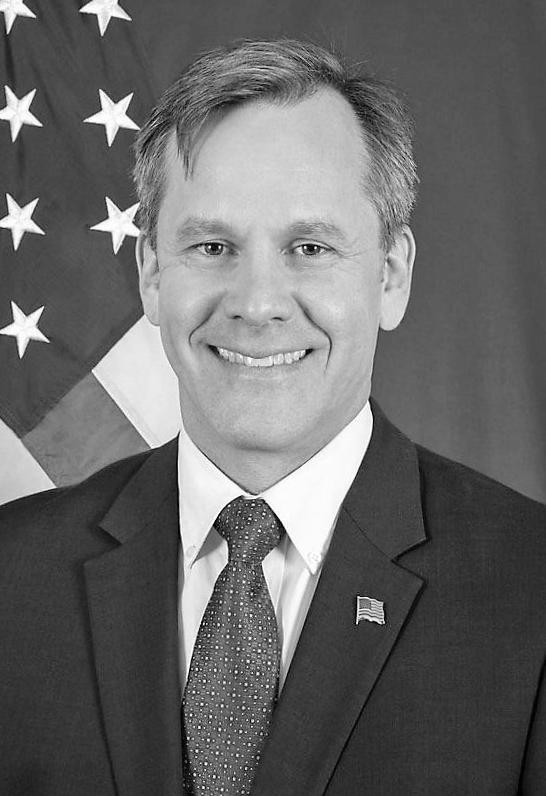
ing Center at Camp Grayling, which is about a 100 mile drive from Big Rapids.
“We train Taiwanese troops there, so I think it was for a reason that that was selected by Gotion,” Cella said. “China will look for any opportunity to establish themselves and to gain an advantage.”
Cella said he regularly cites U.S. Secretary of State Anthony Blinken, who said in a “Face the Nation” interview,
O’Grady aims to flip state Supreme Court seat with Arnn endorsement
By Kamden Mulder Features Editor
Wendy O’Grady knew her husband would do great things — and now Judge Patrick William O’Grady is running for the Michigan Supreme Court.
“He’s a very smart person, he loves law, and he’s very calm and methodical,” Wendy O’Grady said. “He brings a lot of reason to a lot of conversations, which I think is impressive.”
Patrick O’Grady joins Michigan State Rep. and Hillsdale College alumnus Andrew Fink, R-Hillsdale, on the ballot this November. Both men are running for the Michigan Supreme Court, with two seats up for grabs in the upcoming election.
Patrick O’Grady currently serves on the 15th Circuit Court in Coldwater as the circuit judge and has presided over 14,000 cases in his 15-plus years of experience. Prior to running for the bench in 2008, Patrick O’Grady served his community in various capacities, all of which have led him to run for the Michigan Supreme Court.
“I’ve had the call to serve ever since I was a trooper,” Patrick O’Grady said. “I truly believe this is a thorough level of experience to bring to the Supreme Court.”
While in law school, Patrick O’Grady became a state trooper and patrolled the evening shift in Jonesville. By day he was a law student, and by night a state trooper, but Patrick O’Grady was also a full-time dad. According to Wendy O’Grady, the two met in high school, and growing up with Patrick O’Grady instilled a strong faith in her husband’s abilities and intelligence.
“It does surprise him. It doesn’t surprise me,” Wendy O’Grady said. “He attended law school at the same time while being a state trooper and raising a family. Watching him navigate that and grow into it was impressive. And we would look back over the years like, ‘How did we do that?’”
After completing his undergraduate degree at Western Michigan University, Patrick O’Grady was stationed at Fort Gordon, Georgia.
Patrick O’Grady credits those experiences for why he is fit to serve the state as one of its next Supreme Court justices.
“Every step informs the next,” Patrick O’Grady said. “You’re out there with people at their worst moment when they call 911 asking for help. You better understand the nature of the service when you are meeting people at their worst.”
Patrick O’Grady received the
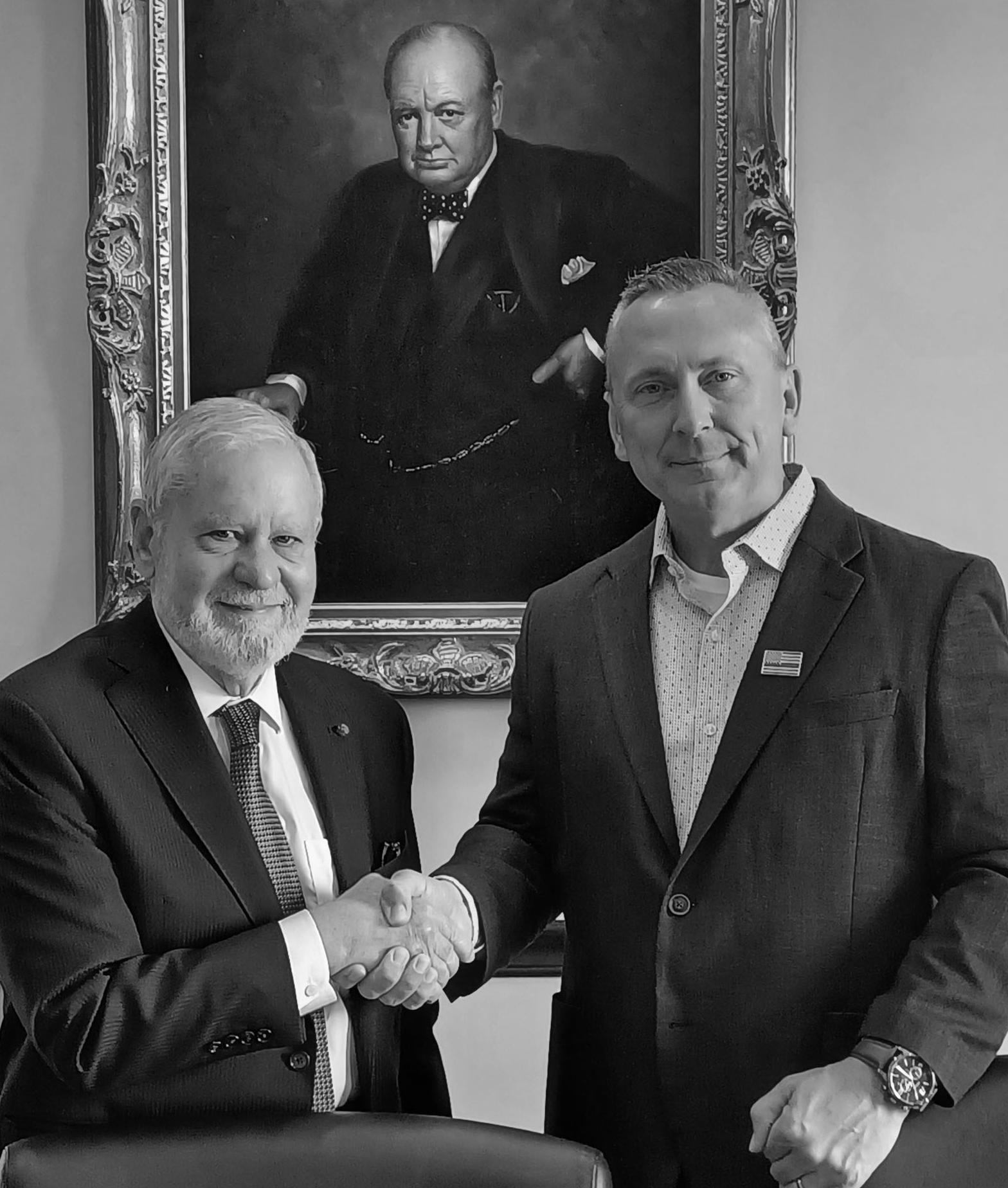
Republican nomination at the GOP convention on Aug. 24. He is running against current Michigan Supreme Court Judge Kyla Harris Bolden, appointed in 2022 by Democratic Michigan Gov. Gretchen Whitmer.
In a campaign rally in Potterville, Michigan, former president Donald Trump gave Patrick O’Grady a shout out leading up to November’s race.
“Another one, highly respected,” the former president said. “Whatever you are doing, keep it going.”
With O’Grady running against the Democratic incumbent, and Fink vying for the seat left vacant by Republican Justice David Viviano ’94 — another Hillsdale grad — victories for both men in November could secure a Republican majority on Michigan’s highest court.
The O’Grady family has long-standing connections to Hillsdale, as well as other rural Michigan communities.
“I bring a perspective of roughly 60-75 counties that are not currently represented on the bench,” Patrick O’Grady said. “Lots of judges come from large metro areas and I can add the perspective of those counties from rural Michigan.”
According to Wendy O’Grady, the family became familiar with Hillsdale when their eldest daughter, Paige, started
high school at Hillsdale Academy. Their son Shane graduated from the college in 2022 and their youngest daughter Ella is currently enrolled at the academy. Wendy O’Grady works at the college as the executive secretary to the vice president of finance and treasurer.
“I’ve been a volunteer at Hillsdale College and volunteer at Career Services on a yearly basis,” Patrick O’Grady said. “Hillsdale is a great place to understand fundamental learning.”
Hillsdale College President Larry Arnn recently endorsed Patrick O’Grady.
“Judge O’Grady has distinguished himself in law enforcement, as a husband, as a father, and as a member of our community,” Arnn said. “He will be a splendid justice for the rule of law and has my full support.”
Patrick O’Grady describes himself as a “Rule of Law” judge, a philosophy he plans to bring to the court if elected.
“We should not legislate from the bench,” Patrick O’Grady said. “That is why you elect legislators every two years. The law simply is what it is.”
Wendy O’Grady said if elected, her husband hopes to ground the court.
“He’s the one who’s very methodical and thought out,” Wendy O’Grady said. “He can
“To date, we have seen Chinese companies and of course, in China, there’s really no distinction between private companies and the state.”
Leon Panetta, former chief of staff to Bill Clinton, secretary of defense, and director of the CIA, identified the Gotion deal at a select committee hearing as a security risk, saying the CCP will use it for espionage, Cella said.
Glenn Kowlaske, a 37-year resident of Marshall Township and retired engineering manager, was recently elected as the Marshall Township treasurer. Kowlaske and others beat the previous leadership, who allegedly were not transparent about the Ford-CATL deal made for the 3,000-resident township and 7,000-resident city.
“Chinese companies have a method of operating and they connect back to the Chinese government directly,” Kowlaske said. “It’s that influence that I think people have started to see across the country and the world that becomes concerning.”
Tracy Ruell, a Democratic candidate for Big Rapids’s state representative seat, said Gotion has already been operating in Ohio and California for nearly 10 years, so it’s ridiculous when Republicans say China is going to use the Big Rapids location for spying.
“They don’t need this lo -
cation this close by, right? They’re already here,” Ruell said. “What you haven’t heard of is any poor behavior of Gotion since they’ve been operating in America because it hasn’t happened.”
Since Cella’s group has been engaged with the Gotion plant issue, he said the construction timeline has been pushed back. Additionally, Cella said he believes the Gotion and Ford-CATL deals are in peril of not being built.
“I’m convinced that it will continue to slide,” Cella said. “These are not small projects, and they take years to really build out and become operational despite what they will spin out there.”
Concerned about the jobs of community members in Big Rapids, Ruell said another factory in the Big Rapids Industrial Park, Simonds International, is closing, eliminating middle class wage jobs.
“These are the people who are working their butts off, and they’re barely getting by,” Ruell said. “We need opportunities for middle-class wage jobs in this community, and Gotion has the ability to provide those.”
Ruell said people on both sides of the issue care about the community and America.
“We need to start working for the betterment of our communities,” Ruell said. “There’s a lot more good coming out of this project than there is bad.”
By Ameera Wilson Collegian Reporter
The results of an attempt to recall Mayor Adam Stockford and Councilman Greg Stutchell are coming this October.
Ted Jansen, a former candidate for city council, filed an attempt to recall both officials in April because they voted to give the city’s waste management contract to the highest bidder. Stockford said the vote was unanimous and recommended by the city’s public services department.
The bid has almost expired, with only one month left to collect the necessary signatures.
“At this point the only option left is to file the signatures by Oct. 26,” Chief Deputy County Clerk Abe Dane said. Penny Swan, who previous-
“If successful and enough valid signatures are filed by that date, it would trigger a May 2025 recall election,” Dane said. “The minimum number of valid signatures required for Adam Stockford is 620 between all four wards of the city. The number for Mr. Stuchell is 135 from Ward 1 of the city.”
Another difficulty is the expiration of the validity of signatures.
“An added complication for the recall sponsor is that once a signature is collected, it only remains ripe for 60 days, after which it would be considered invalid by this office,” Dane said.
Stutchell, facing his own potential recall, does not know if the attempt is still ongoing and has not heard of any new efforts being made.
see both sides very well without getting emotionally charged.”
The O’Gradys have enjoyed campaigning thus far, but it does create challenges for the family.
“For me, it’s getting to engage with people across the entire state and going to counties where I’ve patrolled and lived speaking to thousands of people,” Patrick O’Grady said. “It’s been wonderful to listen to the families and people.”
The judge’s family has traveled with him to a few of the campaign events, but according to Wendy O’Grady, their priority is always their family.
“The hardest part is that we still have a child at home, and we don’t want to forget that we’re still a family,” Wendy O’Grady said.”We still like to have dinners together and we’re trying to maintain a family schedule. I think the hardest part is keeping the family unit still intact, as it should be. That’s very important to us.”
Family means a lot to the O’Gradys. While the time away from home is hard, Wendy O’Grady said she appreciates the man Patrick O’Grady is.
“He loves the ’80s, and you probably can’t stump him on a line or a lyric out of a movie or a song out of the ’80s,” Wendy O’Grady said.
“If enough valid signatures are filed by that date, it would trigger a May 2025 recall election.”
ly filed recall attempts against Stockford, said he should be recalled.
“He throws his own city employees under the bus because he doesn’t understand the budget,” she said.
Swan said the recall effort may still succeed.
“Recalling Stockford has a chance of success,” Swan said. “Just look at the state representative race numbers in the City of Hillsdale.”
Stockford lost Wards 1, 3, and 4 in his recent state representative bid and only won Ward 2 by two votes.
Stockford told The Collegian he has not been paying attention to the efforts.
“The city has a lot of important business in front of us and I’m focusing on that because that’s my job,” Stockford said.
Even if enough signatures are collected and filed, there would be a long process to come.
“I have not received any negative feedback from anyone,” he said. Because of this, Stutchell said will continue to serve, as he has for the past six years. Recall attempts in Hillsdale County are not uncommon, according to Dane.
“In the past four years there have been 11 attempts to recall elected officials in Hillsdale County,” Dane said. “Only two of those have been successful to the finish. Those two were the Adams Township Supervisor and Clerk in May of 2023.” Stutchell said he saw this effort as a way for people to express their views.
“People have a responsibility to exercise their concerns,” Stuchell said. “The better approach would be to have a discussion beforehand to ensure everyone understands the facts and reasoning behind decisions made in council.”
Cassie Devries Collegian Reporter
Hillsdale Men’s Club Soccer beat Saginaw Valley State University 2-0 Sept. 9 at Hayden Park.
Freshman Frank Fehringer scored both goals for the Chargers, with the second goal coming off a shot from midfield.
“I don't think I've ever seen a shot like that second one,” junior Dylan Hughes said. “It was super cool for the fans and really fun for the team. Our coach grabbed someone and threw them. He was so happy.”
Fehringer said he did not expect the shot to go in.
“Mid-game, a couple of the guys were telling me ‘the keeper is out,’” Fehringer said. “So the next time I got the ball, I just shot it. I thought it was hilarious that it actually went in.”
The Chargers have not conceded a goal yet this season, according to junior Jude Barton.
“Our defense is looking great. My main two shoutouts would be Dylan [Hughes] and Julius [Medu-


There are four ships of length 1 ( ), three ships of length 2 (◀ ▶), two ships of length 3 (◀ ■ ▶), and one ship of length 4 (◀ ■ ■ ▶). Each ship is surrounded by empty water on all sides, including diagonally; no two ships touch or intersect. The numbers along the border indicate how many ship pieces appear in that row or column.

na],” Barton said. “Julius is a freshman and a great addition to the team with a great work ethic, and Dylan's always been a brick wall for us on defense.”
Hughes and freshman Julius Meduna both play center back for the Chargers.
Sophomore Ted Fehringer plays midfield, a position that was under pressure all game, according to Hughes.
“Our coach grabbed someone and threw them”
“They forced us to make some adjustments at halftime because any time you played the ball into our central defensive midfielder, Ted, they were just on him,” Hughes said. “So we had to play around that and play more to our attackers since they guarded Ted so closely.”
The Chargers have grown as a team and improved as an opponent over the past three years. Three years ago, the Chargers lost all but one game, which they tied, ac-
cording to Hughes.
“We were at the bottom of the table,” Hughes said. “We tied once, which was the highlight of our season, which is really sad.”
Hughes said the following year, the team improved and moved toward the middle of the league.
“The next year, we won five games, and were in the playoff conversation for a while, which was super exciting,” Hughes said. “So, we're feeling really good this year. Maybe we’ll finish top of the heap, and the goal is always regional playoffs.”
Frank Fehringer said he thought the home crowd made the game more fun.
“I just liked listening to Simpson heckle all the other players,” Fehringer said. “I thought the fans were probably the best part of the game.”
Charger fans will have their next chance to cheer on Hillsdale’s Men’s Club Soccer this Saturday as they face off against Washtenaw Community College at Hayden Park at 12 p.m.





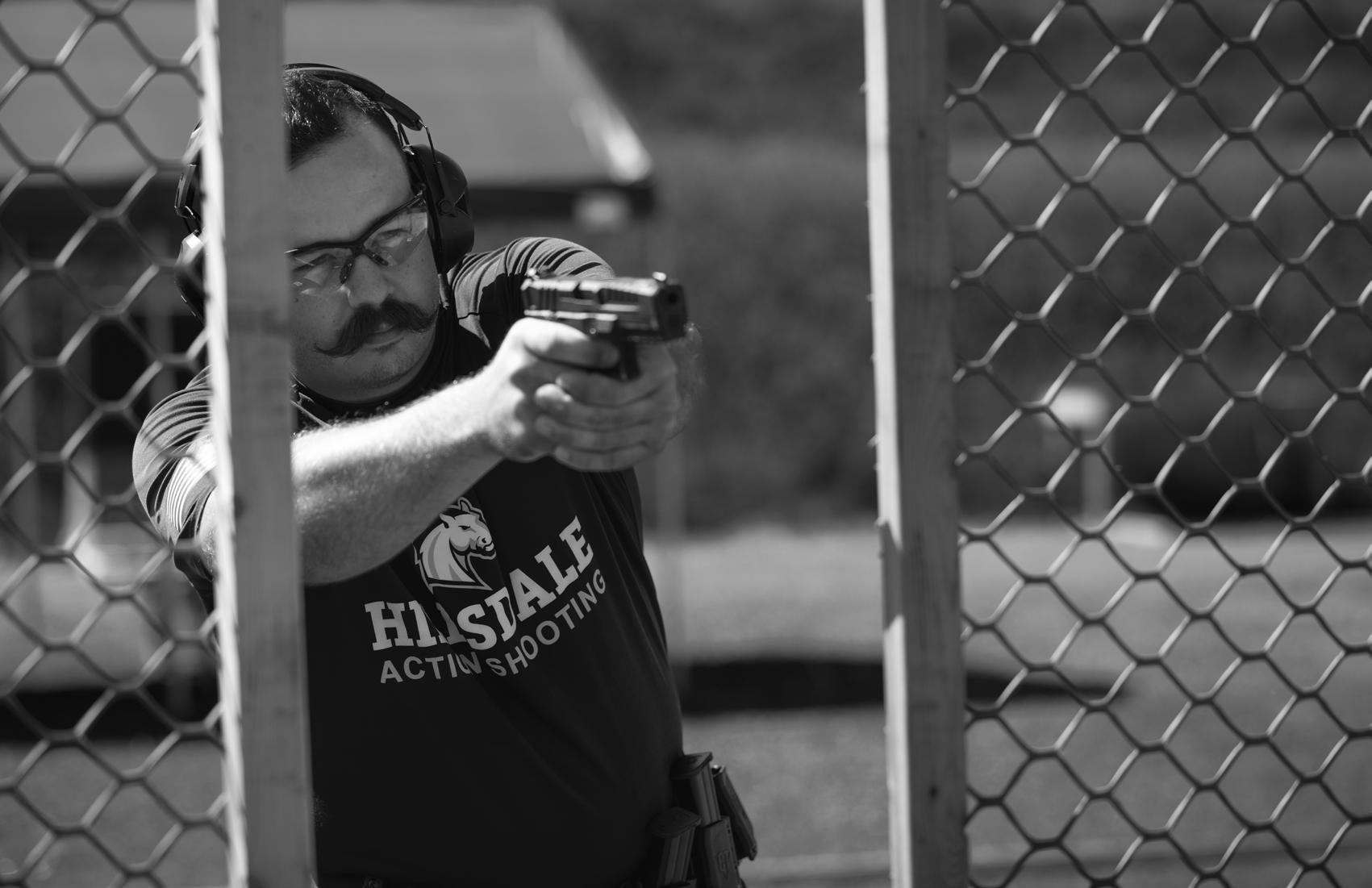
By Alessia Sandala and Sophia Bryant Assistant Editor
Hillsdale College will host the first U.S. Practical Shooting Confederation Collegiate Championship at the Ailes Shooting Range on Sept. 28 and 29.
“This is the first time USPSA has ever done something like this,” sophomore Clara Bozzay said. “I think everyone on the team is excited for the championship because it’s a completely novel element of the sport. It’s cool to be able to create this subculture within USPSA, which is already extremely competitive and an awesome opportunity for a lot of shooters.”
Hillsdale has spearheaded the effort to bring competitive action shooting to the collegiate level, according to junior John Beecher.
“Last fall, we had the U.S. Naval Academy come over and shoot at the first headto-head collegiate USPSA match,” senior Taylor Chen said. “With the success of that we moved forward with the plan for the upcoming 2024 collegiate USPSA championship.”
The Hillsdale Action Shooting Team is sponsored by Springfield Armory, who will also sponsor the upcoming championship at Hillsdale. Chen said Hillsdale’s team has competed at a high level for years and sought to help create a true collegiate program.
“It was a long time in the making,” Chen said. “Four
Baseball
years ago there was only one collegiate championship format and that organization was called the Scholastic Action Shooting Program. However, it was primarily designed for middle school and high school teams, so it had a lot of rules and regulations that catered towards a younger group of individuals.”
Bozzay said she never thought action shooting would be a sport she could compete in at the collegiate level.
“I shot a little bit with my dad back home and that is what got me into the sport,” Bozzay said. “I never took it seriously or as an option for a collegiate sport until now.”
Bozzay said she tried out in the spring but was encouraged to try again in the fall. She was on the team for one week before her first match.
“They onboarded two other people, and I got an email encouraging me to practice over the summer a little bit and try out again,” Bozzay said. “It was a really lowstress tryout, and the coach wasn’t expecting anything perfect, so there is low pressure going into the opening competition this weekend.”
Hillsdale’s Action Shooting team offers its new members a unique opportunity as the team goes into this United States Practical Shooting Association season with the upcoming championship.
“It was a fast turnaround, especially for the new recruits, but we’re really excited,” Bozzay said.
Action shooting consists of stages where each team member must shoot a series of targets with both speed and accuracy, according to Beecher.
“It’s similar to golf. A six stage match would be like a six hole golf course,” Beecher said. “You go to a bay and then they have a different array of targets and different shooters are in different spots with different obstacles. You have to plan your course of fire and then shoot them as quickly and accurately as possible. Then your score is the number of points based on how accurate you were on each target divided by the number of seconds it took.”
The championship, hosted by Hillsdale, will include six stages for each day of the competition. While action shooting teams are typically only prominent at service academies and colleges with ROTC programs, Beecher said Hillsdale hopes to bring competitive action shooting to colleges across the country.
“We’re trying to use this to help other colleges get their action shooting programs off the ground,” Beecher said. “Hillsdale definitely has the foremost program in the country. We’re trying to make it so that other schools can also have something similar to Hillsdale’s program, where they have their own range and they’re a varsity sport.”
Ellie Fromm Assistant Editor
Hillsdale baseball welcomed 14 freshmen to the team this year, replacing the 15 players the team graduated in May and one player who transferred out.
“We are going to be a very useful team, and there’s a lot of things that come into play when you have a team of mostly freshmen and sophomores,” head coach Tom Vessella said. “The structure of our roster looks really strong. I’m really excited to get these kids in.”
Freshman Niko Michaelides is looking forward to the season and said practicing at the collegiate level improves the individual and strengthens the team.
“The transition has been great,” Michaelides said. “The
coaches and players are great. The pace of practice is way faster, which means everyone is able to get more work in the small amount of time we have.”
Sophomore Luke Miller said the incoming class is talented and will be given chances to prove their readiness this fall before the regular spring season.
“We have three fall games, so the freshmen will all get the chance to play in those games,” Miller said. “They’re going to get the chance to show their stuff and see whether they can make the transition quicker and be able to win games.”
Freshman Brodie Romnek said the freshmen class is focused on becoming better and performing at a higher level.
“We expect to work hard
and get better every day,” Romnek said. “We need to push each other and do our jobs to help the team win.”
The full list of freshmen can be found on the Chargers’ website: Nate Albanese, Gibson Cary, Jake Figman, Will Lehman, Robert Matteson, Niko Michaelides, Mana Nicholas-Bublick, Billy Porotsky, Brodie Romnek, Brenden Smith, Tyler Sowers, Gaard Swenson, Carson Tucker, and Dylan Whitfield. Vessella’s team mentality is based on merit and ability. He plans to start and play his best players, regardless of class.
“Our philosophy when it comes to the lineup is that the best players play,” Vessella said. “Class isn’t really a consideration for us. If you’re the best, you’re going to help us win. That’s what we are going to put in the lineup.”
By Malia Thibado Collegian Reporter
Freshman Yvonne Botha traveled more than 8,000 miles from South Africa to southern Michigan to take advantage of both the academic and athletic opportunities in America that were unavailable in her native country.
Botha is from Limpopo, South Africa, the northernmost province of a country known for its abundant wildlife and cultural heritage.
“It’s a little tropical paradise, surrounded by mountains,” Botha said. “There’s a lot of bananas, citrus, mangos, and lychee.”
Botha recalled her childhood, during which she spent months in the neighboring countries of Zimbabwe and Mozambique with her father and brother. They went on wildlife trips and played on the beach in one of South Africa’s rare safe spaces for children.
Attending Hillsdale College is Botha’s first long-term trip outside the African continent.
One factor in Botha’s decision to attend Hillsdale was the college’s swim team.
Botha said she swam competitively since the 8th grade, when her school coach told her she should train properly.
According to Botha, her best event is the 100-meter backstroke, in which she won her regional championship in 2023 and placed sixth at the South African School Nationals in 2022. She also competes in the 50-meter backstroke and 200-meter breaststroke.
“There are more opportunities in America for me to improve my education and to improve my swimming,” Botha said. “It was kind of a no-brainer because if I had the opportunity, I might as well take it.”
Her older sister, Carmen Botha, attended Hillsdale College as a member of the track team. Yvonne Botha said she had already heard about the college, its values, and its culture.
“I think it’s just because Hillsdale is better for me,” Botha said. “It reflects my personality a little better. It’s
a smaller school, I like the morals and code of honor. It was just very similar to what I grew up with, it felt a little more like I would fit in and feel at home.”
Botha said she felt welcomed by the student body, faculty, and her swim team.
Head swim coach Kurt
duced to Botha through Diane Philipp, Hillsdale’s vice president of student affairs. Philipp said she sometimes assists admissions and coaches with recruiting students.
“Their mom called me last year to say hello after Yvonne applied to Hillsdale,” Philipp said. “Coach Kirner learned

Kirner said Botha has the potential to be a great asset to the team.
“She’s only been in the pool two days for me,” Kirner said. “But I do think she has the opportunity to be a contributor on the team. She’s got a lot of improving to do but she seems like a great kid.”
Kirner said he was intro-
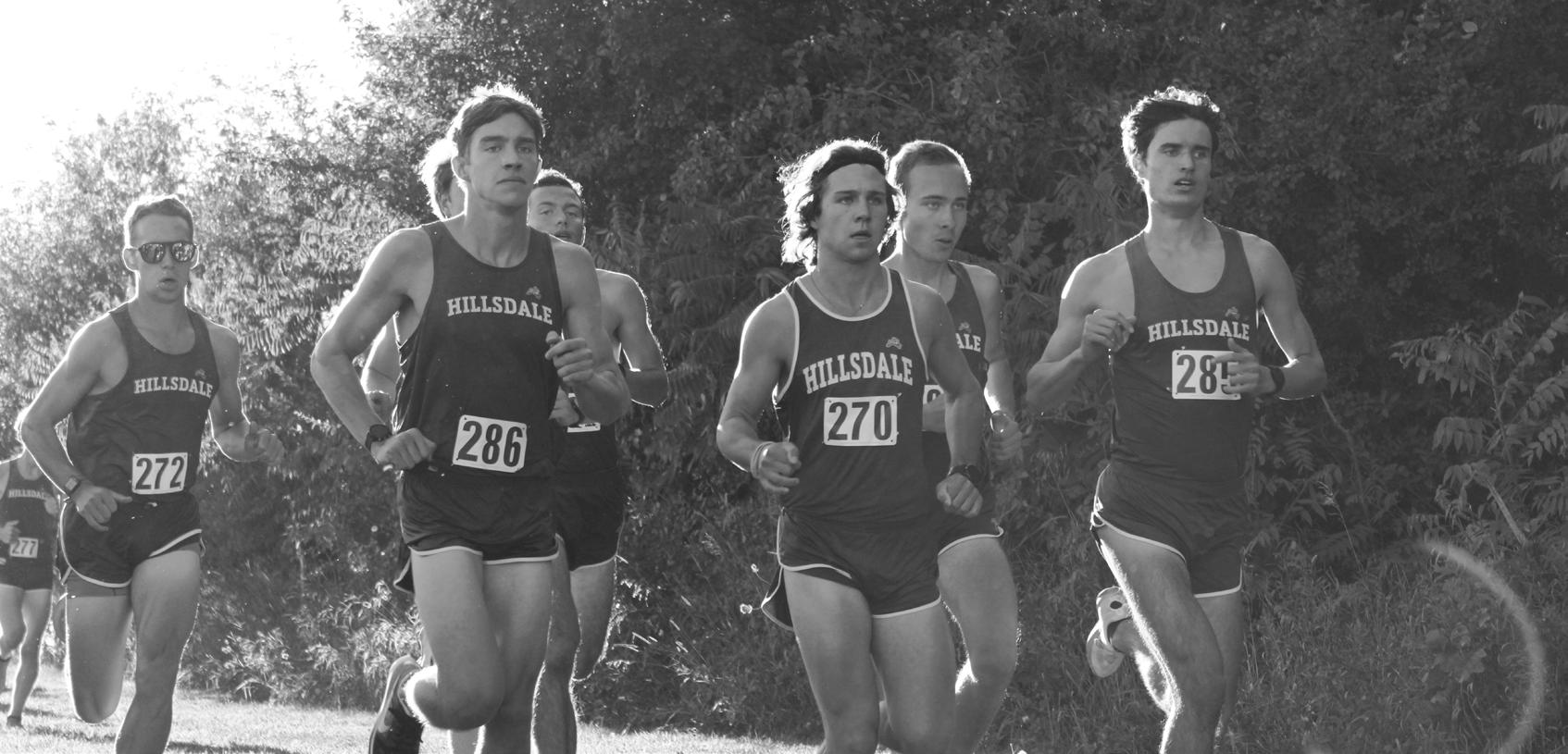
By Elaine Kutas Collegian Reporter
The men’s and women’s cross country teams hosted their season opener at Hayden Park, with three runners from both teams finishing in their teams’ respective top six, despite an overall defeat by nearby Great Midwest Athletic Conference rival Findlay University. This five-kilometer dual meet at Hayden Park was the first home meet Hillsdale has hosted in four years.
Senior Richie Johnston placed third and Lansing Community College transfer junior Gabriel Phillips
placed fifth. Only three seconds behind Phillips, senior Ross Kuhn placed sixth.
“We have a strong top five and some really promising freshmen,” Kuhn said. “Next week, at Wayne State University, we will see exactly what the team is made of.”
The women’s team placed two freshmen runners in the top five.
Freshman Evyn Humphrey won her first collegiate meet, and freshman Allison Kuzma placed fifth. Sophomore Savannah Fraley finished sixth, bringing a third runner across the line in the top six for the Chargers.
“I think this dual meet is
a great start to my career as a collegiate athlete,” Humphrey said. “I was proud to represent my school and my team.”
Junior Anna Roberts reflected on the race with gratitude for the opportunity to be on the team.
“I really enjoyed racing on the new course alongside my teammates,” Roberts said. “I feel even more motivated for the upcoming season after the race this past Friday.”
The Charger men’s and women’s teams will compete at the Wayne State University Warrior Challenge in New Boston, Michigan, on Sept. 13.
about her talents and communicated with the family. The Bothas are a lovely family, and we are excited to have Yvonne here.”
Kirner said he did not have as much time to speak with her as he normally does with prospective student-athletes.
“When I did talk to her, she seemed like a coachable kid,”
Kirner said.“She asked questions. She seemed curious.
The idea that she has the capacity to learn is very important to me.”
Kirner cited the differences between American and international swimming techniques as something Botha might have trouble adjusting to, which Botha confirmed.
“The construction of the swim practices compared to swim practices at home are very different,” Botha said. “The way they name certain drills and phrase it on the program is different. These first three practices, my biggest hurdle has been trying to understand what’s on the program.”
Her home team had practiced technical skills but Botha said she does not have the experience with the conditioning and technical drills that the Hillsdale team does.
“Here you use snorkels, but there we didn’t use snorkels or anything,” Botha said. “I can see how it can help, using the tools, but I haven't figured out how to use it well enough for it to be beneficial to me.”
Botha also said in South Africa they never lifted weights. However, at Hillsdale, the team does lifting and conditioning exercises to strengthen arms, legs, shoulders, and core.
“My body is sore in muscles I did not know I had,” Botha said.
Outside of her time in the pool, Botha said she is enjoying her classes.
“All the professors are very nice, and you can feel that they really want to teach you,” Botha said. “It’s really refreshing. Because you feel the teacher wants to teach you, you want to sit there and learn.”
Although she is enjoying her time at Hillsdale, she said she does miss home sometimes.
“I do miss my mom, my boyfriend, my sister, and my sister’s kids,” Botha said.
Though Botha said she will probably go back to South Africa after her four years of college, for now she is focused on improving in the classroom and in the pool.
By Isabella Doer Collegian Reporter
Hillsdale women’s tennis opened their 2024-25 season with victories in both singles and doubles play at their annual Chargers Summer Invitational on Sept. 6-7, according to sophomore Ané Dannhauser. The Chargers hosted players from University of Findlay, Walsh University, and Wayne State University.
Dannhauser started for Hillsdale in Flight A singles. After a 5-7, 0-6 loss to her Findlay opponent, Dannhauser went on to win the Flight A consolation bracket title. She defeated a Walsh opponent 6-3, 4-6, 10-4, and capped her run in the final with a 6-3, 7-5 win over a second Walsh opponent.
“This past weekend was a very solid start to our short fall season,” Dannhauser said. “It was great getting back into matches. We played against some tough schools and showed that we have what it
takes to compete with them.”
Senior Elizabeth McGivern also competed in Flight A singles, but lost to Wayne State 3-6, 1-6.
In Flight B singles, freshman Briana Rees took the first set 6-4 against a Walsh opponent but was unable to maintain her lead, losing 0-6, 3-10 in the tiebreaker. Senior Courtney Rittel played a Wayne State opponent in the
“We showed that we have what it takes to compete”
same flight and lost 4-6, 1-6.
Junior Isabella Spinazze lost 4-6, 3-6 to a Wayne State opponent, and freshman Julia Zlateva came up short 2-6, 4-6 against a Findlay opponent in their Flight C matches.
For doubles in Flight A, Dannhauser and Rees lost 6-7, 5-7 to Findlay and Rittel and Zlateva dropped 2-6 to
Wayne State. Both matches were in the quarterfinals. Additionally, in Flight B doubles, McGivern and Spinazze came up short in two sets against Walsh, 6-7, 2-7.
“This weekend was an early start to our fall season, having come off of only three days of practice as a team,” McGivern said. “Even though we didn’t see very many wins this weekend, I think the team had great energy and enthusiasm despite that, and it was awesome to have coach Nikki back with us.”
The Chargers will compete in the 2024 Intercollegiate Tennis Association Midwest Regional at Davenport University in Grand Rapids Sept. 14-16. This three-day competition will feature top National Collegiate Athletics Association Division II singles and doubles players from across the Midwest.
“We have a lot to work on,” Rittel said, “but I am very confident and excited for the weeks to come.”
What book should everyone read?
Everyone should read "Where Men Win Glory." It is a great book on sacrifice.
What is one thing you want to memorize?
I'd like to memorize some more Bible verses. I've only got a few that I can recite.
Compiled by Charlotte Knobloch

Courtesy | Hillsdale College Athletic Department
What character trait is important to develop?
You have to be a good leader no matter your role. The best teams have great leaders all around.
What is something people would not expect about you?
People probably wouldn't guess that I enjoy a musical every now and then.

By Alex Deimel Collegian Reporter
The Hillsdale football team opened its season with a home loss against the University of Indianapolis Greyhounds on Saturday night in a 42-16 final score at Muddy Waters Stadium. After some offensive struggles in the first half for the Chargers, the 16th-ranked Greyhounds took a 28-7 lead into halftime and never looked back.
A new Charger offensive squad under head coach Nate Shreffler saw issues early in the first half, failing to reach the first down marker on four of their first five drives, and fumbling the ball on the second offensive drive of the game.
“Obviously, we got punched in the mouth,” senior wide receiver Logan VanEnkevort said. “They’re a great team that came out ready to go. We came out a bit too soft. They surprised us.”
VanEnkevort, who suffered a shoulder injury during the game, rushed for nine total yards on Saturday. Senior running back Kyle Riffel handled most of the ground game for the Chargers, ending the game with 42 rushing yards and one rushing touchdown.
Sophomore transfer quarterback Cole Canter started his first game in a Charger uniform, throwing for 260 yards, one touchdown, and three interceptions, two of which came on the last two offensive drives for Hillsdale. “Even with the loss it felt
good to be here,” Canter said.
“The crowd was great and it helped to have them behind us.”
The Chargers saw some offensive success in the second quarter when Canter hit sophomore wide receiver Shea Ruddy for a 61-yard touchdown to cut the Greyhounds lead to 14 points before halftime. Riffel scored the other touchdown for the Chargers on a two yard rush in the fourth quarter.
Sophomore wide receiver Johnathan Metzger contributed to the Charger passing game with two receptions for 64 yards, including a 39-yard catch from Canter at the beginning of the fourth quarter while the Chargers faced third down and 28.
After the first half, the
Charger defense came out strong and held the Greyhounds scoreless in the third quarter. They also scored two points when junior defensive lineman Hunter Sperling stopped the Greyhounds running back in the end zone for a safety.
Junior linebacker Jacob Vance, who led the Chargers in tackles last season, totaled eight tackles against the Greyhounds, including three tackles for a loss.
“It’s more about the process than anything,” Vance said. “Obviously we never want to lose, but we’re still going to do the same thing and the same routine as we’ve been doing. We definitely could work on our communication, but I think we’ll be just fine.”
The Chargers play Sept.
By Ellie Fromm Assistant Editor
Charger volleyball posted
a 2-1 record Sept. 6 and 7 at the Tampa Volleyball Classic hosted by the University of Tampa Spartans.
14 at Michigan Technological University in Houghton. Hillsdale has lost five straight games against Michigan Tech.
“I think if we can fix smaller mistakes, we can have a much better start to the year
than last season,” VanEnkevort said. “Obviously we have a tough schedule to start the year, but we want to kick it into gear this year earlier than last year, and I have no doubt we can accomplish
“The competition was highly ranked, and playing them forced us to take a step forward in our development,” Gravel said. “Although Tampa is now 3-0 in the preseason, our biggest opponent remains ourselves.”
Junior Josie TeSlaa thinks each team they faced brought a new challenge and different style of play.
“Each team brought a different type of skill and energy,” TeSlaa said. “For example, New Haven was a scrappy team, Texas Woman's
The Hillsdale Chargers defeated the University of New Haven Chargers 3-0 on Sept. 6. They then beat the Texas Woman’s University Pioneers 3-2 and lost to the Spartans 1-3. As of Sept. 9, the Spartans are ranked first by the American Volleyball Coaches Association in the 2024 Division II Women’s Volleyball Poll. Head coach Chris Gravel believes the quality of the Chargers’ opponents allowed them to test everything they had worked on during the preseason.
had great serves and a more physical offense, and Tampa was very technical and brought a lot of power in their serves and attacks.”
Redshirt sophomore Chloe Pierce said the Chargers played hard throughout the tournament, aiming to leave nothing to chance.
“This team did such a good job of leaving it all on the floor,” Pierce said. “We also have worked hard on communicating productively with each other on the court and focusing on what needs to be done to win, and I think that really showed in our play.”
In preparation for upcoming games, Gravel intends to
focus on the specific aspects of the game that needed work last weekend.
“Although greatly improved, our serving and passing will be the focus of this week,” Gravel said.
The Chargers will play the Clarion University Golden Eagles Sept. 13 at 5:30 pm for Neon Night. On Sept. 14, the Chargers take on the Florida Southern College Moccasins at 11 am and the Purdue Northwest University Pride at 5:30 pm for Freshman Night. All three games are a part of the Chargers Net Result Invitational and will be played at Dawn Tibbetts Potter Arena.








By Michaela Estruth Senior Editor
Up and coming artists performed a mix of favorite country songs and original pieces despite technological difficulties during Student Activities’ annual Concert on the Quad on Friday, Sept. 6. Due to the ongoing construction on Hillsdale’s main interim of campus, commonly known as ‘the Quad,’ SAB relocated the event to outside of Lane Hall. SAB members set up a stage, lights, coffee, and donuts and featured live music from 6 to 11 p.m.
A highlight of the night, about halfway through, senior Gregory Whalen shared his original piece, “Nineteen,”
based on real stories from Marines who lost their lives in the withdrawal from Afghanistan on Aug. 26, 2021.
“I was a Marine with 1st Battalion 8th marines in Afghanistan for the evacuation,” Whalen said. “The song ‘Nineteen’ is very loosely based on some of those details and is meant to be a memorial to all 13 who were killed.”
Whalen said performing ‘Nineteen’ at Concert on the Quad was one of his first live performances, besides sharing it with family and friends and once at Rough Draft.
“It is always a kind of gamble playing that song live because I never know for sure how I myself will react,” Whalen said. “The emotions at -
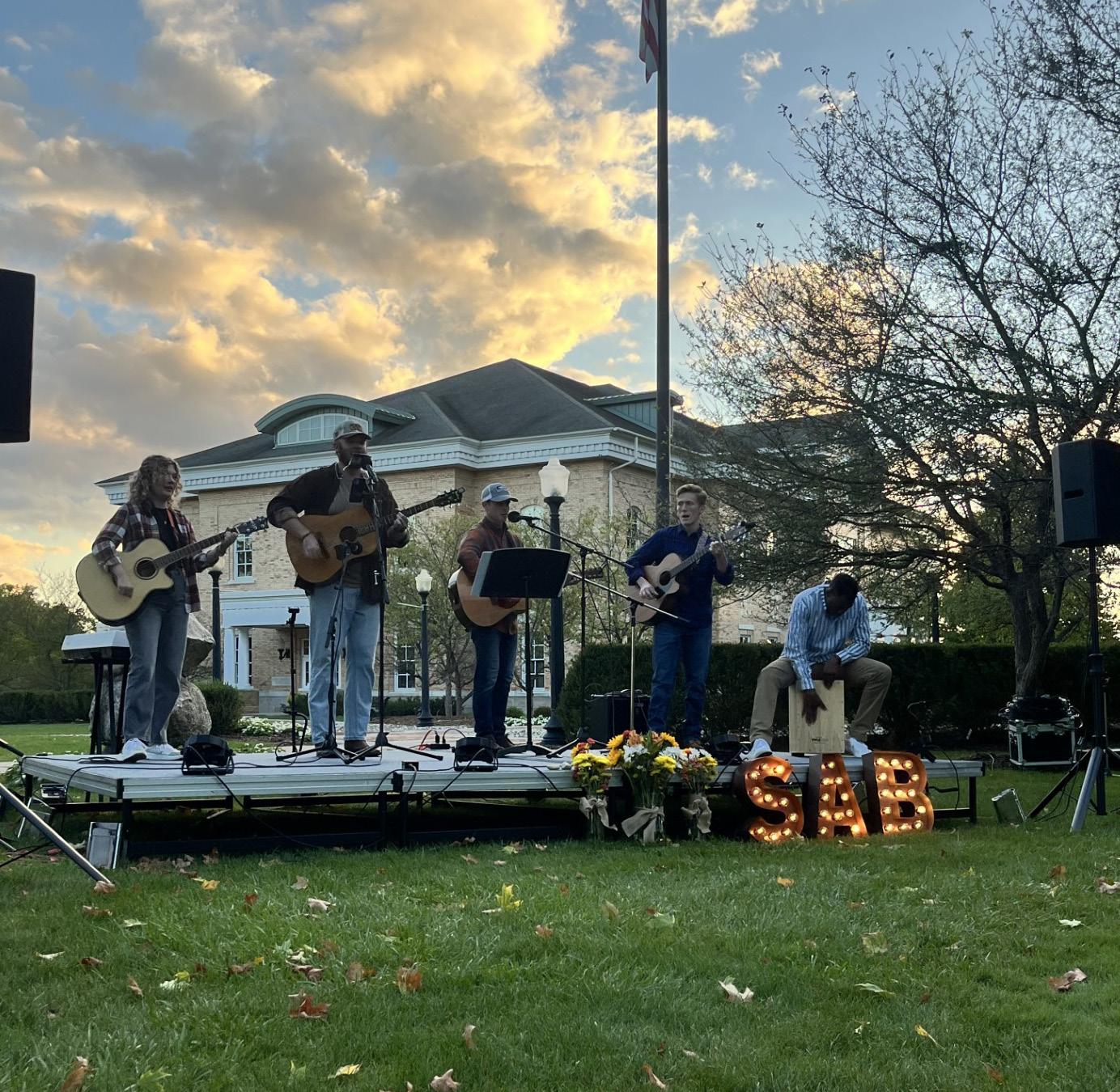
tached to that experience are still just under the surface.”
The song’s verses imitate would be letters that a husband wrote to his newly wed wife.
“I wish I could be there, and hold the woman I love,
And our soon to be baby girl.
She’s gonna steal my whole world.
. . . I can’t wait to come home.”
In verses five and six, the climax hits with the reality the listener has dreaded: news of the soldier’s death.
“I guess that you’ve heard by now, the news comin’ from the tv.
There was a bomb last night,
And I ain’t alright.
I’m finally comin’ home, not the way I planned, not the way you want.
All that you’ll get of me,
The red, white and blue folded nice and neat.”
Whalen concludes the song with the heavy words:
“. . . Never thought I’d die at nineteen I was just nineteen.”
Whalen said he wrote the song in dedication to the men who gave their lives and hoped to honor the memory of those 13 killed in the evacuation.
“I hope to inspire a greater awareness and sense of responsibility for what we do as a country,” Whalen said. “The currency that our government deals in is human lives, and we all need to take that seriously.”
Whalen said “Nineteen” is one of three songs he wrote
dedicated to the evacuation, and all three are on the major music platforms under “Greg Whalen” or “American Deployed.”
Immediately before Whalen, senior Isaac Green also debuted an original, but he was robbed of the full performance when the sound cut out in the middle of his performance. This was the second time of the night the sound had failed during Green’s performance. Green said he was confused when it first happened but wasn’t too concerned.
“I thought, ‘oh somebody must have just tripped over the power cord and they’ll have it back up and running soon.’” Green said. “I thought it might be the end of the set since the event was already running a little behind, but they let me keep going once they got power back, which was very nice of them.”
Green said he wrote his original at the request of his sister-in-law and performed it at their wedding to surprise his brother.
Green said he used his sister-in-law’s written vows for inspiration of facing life together–a major theme of the lyrics.
“We made it home my dear And I only wanna sail along if you will help me steer.”
But audio cut out again in the middle of Green’s performance.
“When the audio went out for the second time in the
middle of the original, I just leaned my head back, laughed, and thought, ‘well that’s probably the end of this set,’” Green said. “It would have been fun to play the whole thing, but I wasn’t too worried about it. I had a great time, and there will be plenty of other opportunities to perform it in the future.”
Event team lead and senior Abby Richardson said the breakers were switching off because of dew exposure which was interfering with the sound. Eventually, SAB members re-
student activities said.
“The cinnamon donuts always go faster than the plain,” Dornbirer said. “So we were prepared this time.” Students packed the designated space for most of the evening. Senior Hannah Arends said Concert on the Quad is her favorite SAB event.
“It’s the perfect fall kickoff,” Arends said. “I love going with my friends, and it was especially sweet this year with it being our last time.”
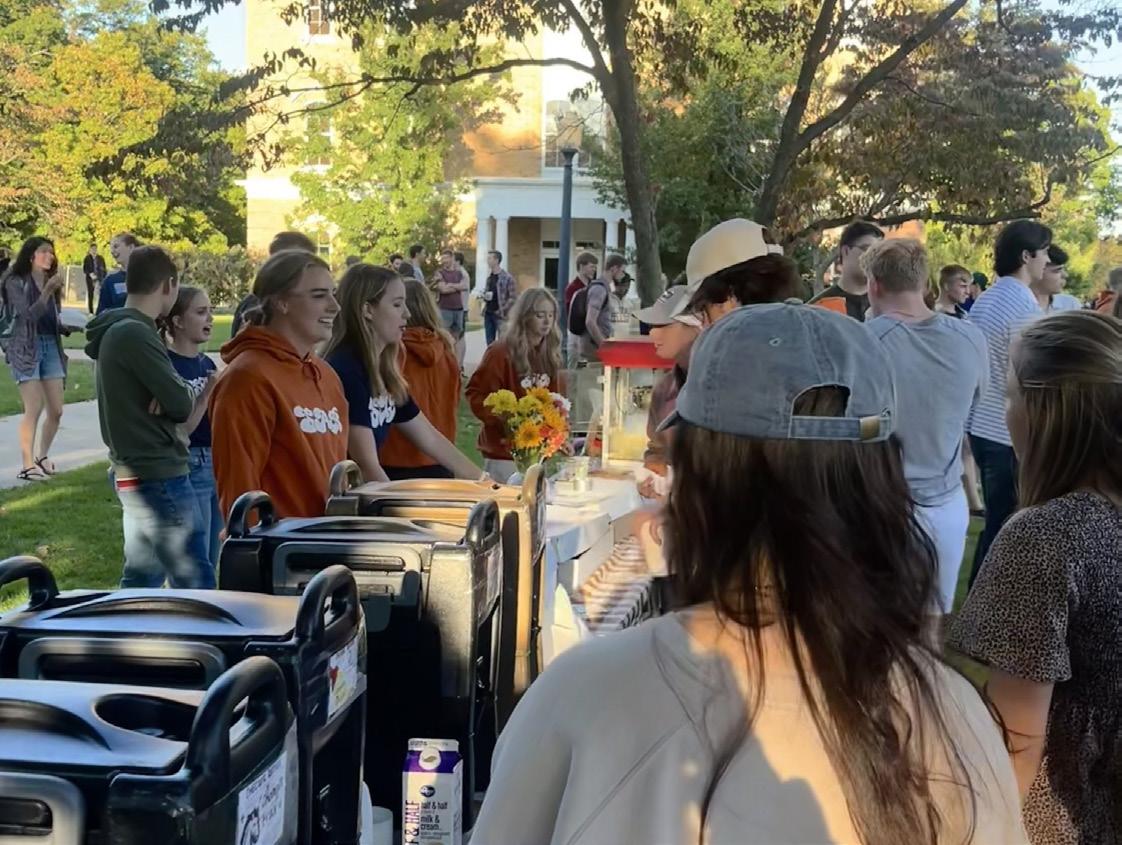
sorted to setting up speakers and blasting the volume from the front instead of all around the designated area.
Besides the technical difficulties, SAB members said they made adaptations from previous years to enhance the experience. The night presented 12 performances instead of the traditional eight. SAB also ordered more cinnamon donuts, Ingrid Dornbirer, director of
Green also shared Arends sentiment, despite the technology issues.
“Even with the technical difficulties, it was probably still my favorite Concert on the Quad experience yet,” Green said. “SAB did a fantastic job with the set up near Lane. It’s just a really cozy and beautiful location. And all the other performers I saw did a great job with their sets.”
By Ally Hall Design Editor
A Lynyrd Skynyrd concert at a Michigan casino in August
2024 is precisely what you’d expect a Lynyrd Skynyrd concert at a Michigan casino in August 2024 would be: a slew of muscle tees, melted makeup, bad facial hair, “wife beater” tank tops, and Miss Me bedazzled jeans. It could have been the crowd at a Trump rally, except these fans had gathered at the Soaring Eagle Casino in Mt. Pleasant, anxious to hear American’s iconic southern rockers.
ZZ Top opened for Skynyrd, but because I chose to go to a concert more than two hours away with men, we missed the whole set. A Lynyrd Skynyrd concert seemed to be the same level of importance to my male friends as getting ready as prom is for high school girls. Exchange the floor-length gowns for jean cutoffs and you’ve got yourself an even exchange.
Johnny Van Zant, the lead of Skynyrd since 1987, led the charge with “Workin’ for MCA.” The crowd was mi -
grating between the assigned aisles, Ticketmaster gatekeeping of special seats at the front be damned. Shortly following the intro song was the highlight of the entire show, the 2009 track “Skynyrd Nation.” “Young and old (young and old)/ Three generations bold (generations)/ We’ve been told / It’s a Skynyrd Nation!” Led with the intensity of a television pastor at a smoke-machine filled, LED-ridden megachurch, Van Zant riled the crowd up further with the anthem of the fandom. Everyone seemed to know the words except me and my friend, the two youngest people there by 30 years. Minimum. Classics like “Whiskey Rock-a-Roller,” “The Ballad of
Curtis Loew,” “Simple Man,” and “Sweet Home Alabama” entranced the audience from
playing old live clips, produced visualizers, and even candles with the names of deceased

start to finish. Billy Gibbons of ZZ Top even came out for a cover of J.J. Cale’s “Call Me the Breeze.” Each song was accompanied by a massive screen dis-
members beneath them. Obviously, this was the perfect setting to scream “Free Bird” between every song until they stumbled back onto stage after their fake hibernation.
What I found to be a charming performance of people enjoying the final throes of a great American rock band made others in my group depressed. Their criticisms of humiliating Baby Boomers displaying slovenly behavior while the whole world is falling apart fell short. This didn’t feel like the circus at the fall of Rome, but rather an endearing display of human delight.
What I saw was a group of musicians who were hyper-reverent of the legacy they strummed along and who were happy to be performing to a dedicated audience. Too often artists can seem aloof or disinterested on stage, like they’re racing through a setlist to ful-
fill a record label demand. The Skynyrd show wasn’t like that. Albeit performative at times, the joy seemed as real as the clouds of body odor and Coors carbonation that hung in clouds over the stands. It doesn’t matter if this Skynyrd tour leg was a money grab by washed up old rockstars. They gave audience members what most of us can only dream of doing: giving others a priceless few hours of levity, joy, and fun.
We made it through most of the set without random strangers accosting us, but right before the show ended a woman who was the human embodiment of a Marlboro Red grabbed ahold of my concert buddy.
“You better raise your kids on rock ‘n’ roll,” she growled at us, beer slopping onto the floor as she pointed to me. I assured her we would, despite the fact that I wanted to tell her I’d never marry a man who’d make me arrive late to a concert. Even if it was a Lynyrd Skynyrd show at a casino in Michigan in 2024.
By Zack Chen Assistant Editor
Last year, I gave up complaining about Emily Wilson’s translations of Homer for Lent.
I’ll admit it was unjustified at the time — most of my experience with Wilson came from hearsay, several secondary reviews of her work (all of which were quite vehement both for and against), a discussion on a few debatable passages with a friend, and the opening line of her translation of the “Odyssey”: “Tell me about a complicated man.”
Wilson is a classics professor at the University of Pennsylvania who completed her undergraduate and master’s work at University of Oxford and her Ph.D. at Yale University. She has most recently become wellknown for her translations of Homer’s “Iliad” and “Odyssey.”
This summer, I decided to work up the courage to tackle the second sentence of her “Odyssey.” While I do strive to give books a fair read before criticizing them, I admit that I expected my journey through Wilson’s translation to be fraught with literary perils. As I had just finished a course in Homeric Greek and recently read book VI of the “Odyssey” in the original Greek, I considered myself prepared to take on any translation decisions Wilson might
throw at me. As prepared as a college sophomore can be, that is.
Two or three books into the epic, I began to be struck by several unexpected considerations. The first was that Wilson’s treatment of Greek and English meter was really quite impressive.
Translating a poem is an impossible task — if you don’t believe me, just try yourself. While a translated poem may approximate the original in some ways, translation can never fully convey the essence of a poem. Wilson’s attempt to render Homer’s Greek dactylic hexameter into iambic pentameter, the English heroic meter, struck me as quite commendable.
Secondly, I appreciated that Wilson’s translation contains the same number of lines as the Greek text. While it does not necessarily guarantee precision in translation or interpretation, line-for-line translation tends to force a translator to remain much more strict and close to the text. Like the renowned Greek translator Richmond Lattimore before her, Wilson is to be praised for accepting this poetic limitation and producing a translation from within it.
The third thing which struck me about Wilson was her translation was very readable — perhaps a little too readable. Her “Odyssey” positively teems with modern English idioms and
simple, straightforward words. Furthermore, Wilson tends to break up longer Greek sentences, rendering them with curt English statements.
On the one hand, this clarity and brevity are two major strengths of her translation.
The Homeric epics used to be recited publicly, and I’m not a fan of gatekeeping Homer by deliberately translating his epics into difficult or obscure English. (This is, unfortunately, a criticism frequently leveled at translators like Lattimore who dislike his more literal renderings of Homeric sentences.) Nonetheless, I applaud Wilson’s ability to produce simple English sentences — the punchiness can be helpful in reading.
It is the duty of the translator to bring the reader to Homer, not Homer to the reader. My weightiest concern with Wilson’s “Odyssey” is that, rather than raising its readers to the heights of the epic, it oversimplifies the poem’s language in an attempt to render it more accessible.
“It is the duty of the translator to bring the reader to Homer, not Homer to the reader”
However, English simplicity is not the most important concern for a translator. Even worse, it can prove dangerous when a translator places more priority on making his or her work easy for native English speakers to read rather than bringing the complexity of the original poem into English.
‘Reagan’: a glimpse
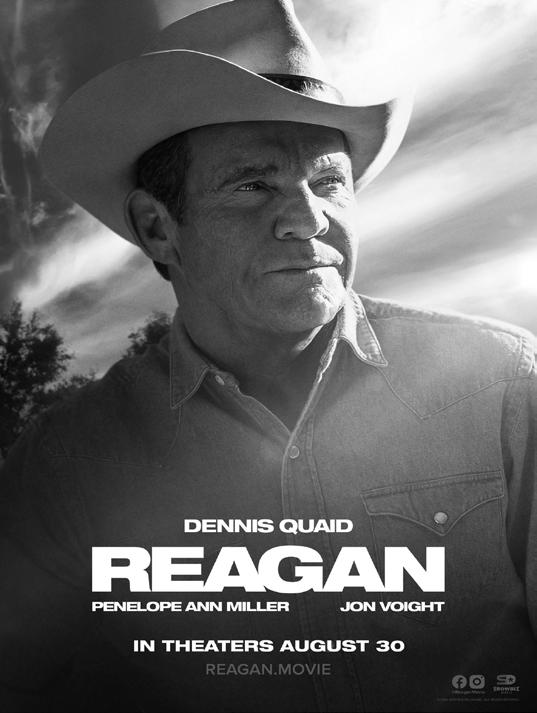
By Micah Hart Senior Reporter
Welcome to the 1980s.
The economy needs saving, the world is filled with chaos and political turmoil, and one of the presidential nominees comes from the entertainment industry.
In an election year unlike any other, “Reagan” serves as both a warning and reminder to Americans of where America was and where it should go. Throughout the film, viewers are reminded of what “Morning Again in America”
means. The film drives home the American ideas of promoting freedom, standing with our allies, and never giving up — no matter who or what stands in our way. The most prominent way in which this is done is subtle, yet impactful to the overall political meaning of the movie.
Instead of an outside narrator explaining the story, the movie is narrated by Jon Voight, who plays Vitktor Petrovich, a former KGB agent. In making this directorial choice, the film perfectly encapsulates Reagan’s foreign policy expertise and the fact that he intimidated enemies, even prior to his rise to political power.
Viewers are reminded of Reagan’s power and convictions, whether it be him cracking jokes after being shot or standing up to the Soviet Union. The film balances both the humorous side of the late president and his ability to make other leaders listen to him.
While the president’s unwavering commitment to free-
While Wilson’s more modern English is easier to read, ease of reading can coincide with tending toward a lower register of writing. This is evident from the very first sentence, in which Odysseus is described as complicated, a word which has practically ceased to convey any genuine meaning or force in today’s English. Lattimore uses the phrase “man of many ways” and Fagles uses “man of twists and turns,” each of which draws upon different aspects of the Greek substantive “polutropon,” but both translators retain at least some of the dignity and weight of the Greek. Wilson’s translation is so simple as to be degrading.
The same ill plagues the
dom shines throughout the movie, it is clear Reagan is not unreasonable. One of the highlights of the film is watching the portrayal of his relationship with then Democrat Speaker of the House Tip O’Neill. Their friendship was one of personality and not politics, which hits home for viewers in America’s current divisive and disheartening political climate.
Besides the political storyline, “Reagan” depicts the former president’s life and struggles. Ronald Reagan did not grow up in a rich and thriving family. Instead, his father struggled with alcoholism, and his mother tried piecing together a family as much as she could. It’s a story of strength and power, as Reagan and his mother fight with faith and hope.
Even amidst the personal storyline, Reagan possesses a strong moral clarity and desire for justice. One of the most compelling scenes in the movie depicts Reagan during his college years. The Gipper, as he would later be called, played on
Eureka College’s football team. While on the road for a game, a hotel denied two black players entry. Reagan invited the two players to stay at his home with his family and him.
Within the film, Dennis Quaid portrayed the multiple hats Reagan wore brilliantly. From Reagan’s strong and powerful rhetoric to his loving and peaceful demeanor around Nancy Reagan, Quaid grasped it. It is one thing to make a movie about Reagan’s politics, but it’s another thing to make a movie about Reagan and who he was. The movie did not politicize his entire life. Instead, it showed the real Reagan. It showed the values he stood for. It showed why he stood for those values.
“Reagan” is not for Republicans or Democrats. It is for all Americans. It is for those who love history. It is for those who want to relive history. It is for Americans looking for a glimmer of hope in the 2024 political world.
“The
Lady Eve.” (1941)
“The Edge of Sadness” by Edwin O’Connor (1961)

The first novel that I enjoyed — I read nothing but baseball and World War II nonfiction before the age of 16 — contains the full spectrum of the human condition. Uproariously funny, comedic in the best sense, and sparkling piece of social history: the pre-Vatican II Irish-American world. Also Philip Roth, “The Great American Novel,” riotously funny, but often off-color, and about my two favorite subjects—World War II and baseball—with a communist plot to destroy America by destroying our national pastime.
by Megan Li Assistant Editor
“Never Stop” by Echo and the Bunnymen (1985)

From big-band jazz – along with baseball and the Constitution, America’s greatest gift to civilization — anything by Count Basie in the late 1930s. From my first love, ’80s New Wave, anything by Echo and the Bunnymen, “Never Stop” probably above all.


Easy, “Pride of the Yankees.” Seriously: “The Lady Eve,” quintessential romcom by my favorite director, Preston Sturges. Also “Broadway Danny Rose,” a hilarious depiction of New York Jews and Italians, and a profoundly Christian movie that my family watches every Thanksgiving.

rest of Wilson’s translation: she constantly uses more informal — dare I say ignoble? — English constructions to render Homer’s verse. As just one of myriad examples, compare Wilson’s translation of Odyssey 4.184 with Fagles’. He writes, “So Menalaus mused / and stirred in them all a deep desire to grieve,” where Wilson writes simply, “His words made everyone want to cry.” A literal rendering of the text would be, “So he spoke, and stirred up a yearning for weeping in all present.” While Fagles adds shades of meaning by his use of semantically broader words like “mused” or “deep desire,” his translation only adds meaning to the text — like all translations, it’s making a reading of Homer, but importantly, this interpretation is not a simplification. By contrast, Wilson’s word choices and sentence structure are bland, flat, and almost unbearably shallow — the sort of thing a school-child might say while attempting to describe a tragic scene. It conveys plot but abandons poetry.
“Wanting to cry” is, I contend, a much lesser affair than “a deep desire to grieve” or even “yearning for weeping.” If you don’t see a difference, you need to read more poetry. The words are the thing itself. This flattening of Homer fundamentally betrays Wilson’s
readers. While the translations of prior translators like Lattimore or Robert Fagles may be more difficult to read, they also convey well the grandeur of Homer’s heroes and their epic struggles. The Homeric hero is seen as he truly is — an imperfect but nevertheless great man of nobility and distinction. Wilson, by contrast, de-emphasizes Homer’s use of repeated epithets, lowers the tenor of her characters’ speeches and words, and brings Homer’s larger-thanlife heroes down to a dull, irritating mundanity.
While I also consider several other aspects of Wilson’s work problematic, such as her portrayal of the serving girls who sleep with the suitors and her emphasis on giving Eurykleia the epithet slave rather than nurse, I believe that these are also expressions of an attempt to render Homer more palatable to the modern reader.
To do so is dangerous, however. Homer was not a modern and we ought not read him anachronistically. Be that as it may, however, to thread the Scylla of over-modernization and the Charybdis of translationese is no mean feat, and even if it has drawbacks, Wilson’s work has its advantages as well.
Translating Homer is itself heroic, after all. You might even call it complicated.
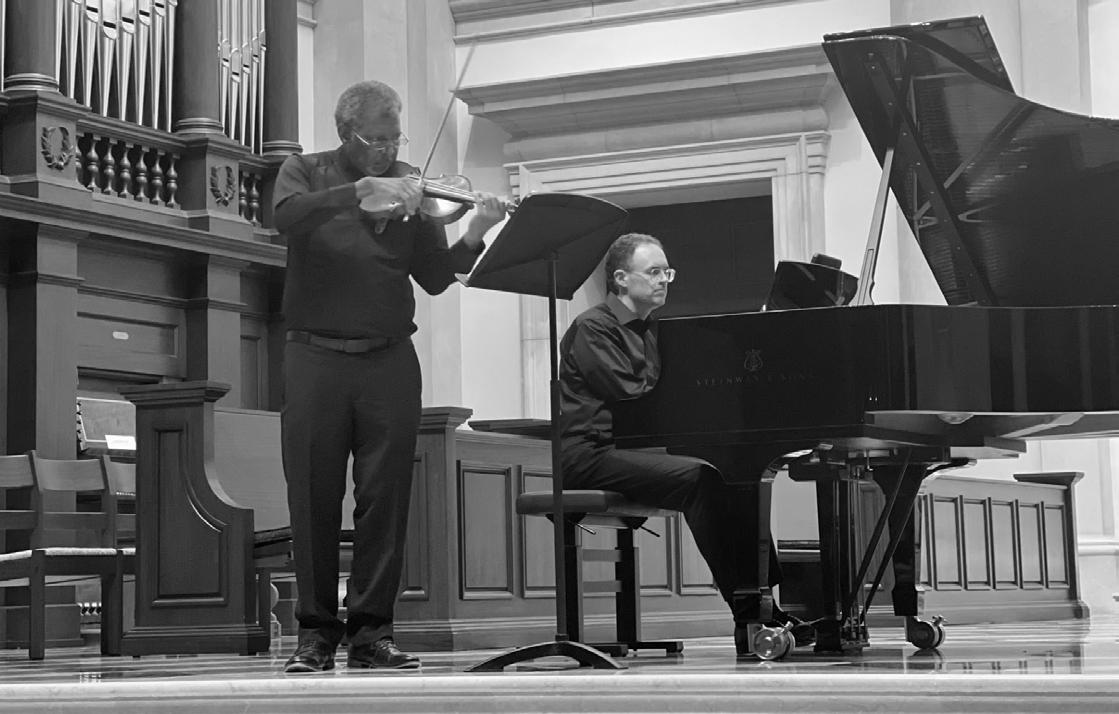
Bengtson is a
professor, and
He is an associate professor of music at the University of Michigan, and he is working on recording a second album with Sierra.
John McLaughlin Williams is a Grammy Award winning composer and a concert violinist, pianist, and chamber musician.
What was your musical background growing up?
Bengtson: My parents were church organists. My dad did that for many, many years. My mother’s parents were very musical but not professional. Their table conversations were nothing but music.
Williams : My parents weren’t professional musicians, but they studied music seriously. There was always music of all kinds in the house. Particularly classical but also popular music like Moetown and the progressive jazz of the day. They were pretty well cultured around music and literature too. I didn’t begin to play until years later in the public school system.
What is your musical inspiration?
Bengtson: I also had a lot of recordings that I listened to growing up, we both have in common that we like to explore music.
Williams: I think initially for everyone, the inspiration is the instrument itself — there’s something about the instrument itself that fascinates us. That’s kind of the portal that leads us into a portal of the music. Sometimes it’s the opposite, you hear a piece of music and you think “oh I want to play that” and you end up being attracted to that instrument as a way of realizing that piece of music. There was something very fascinating
about the violin that kept me interested and the music was the bonus on top.
What work/accomplishment are you most proud of?
Bengtson: It’s hard to rank them, but playing at the Scriabin festival, it’s certainly an experience I had that others hadn’t. Among other things, it’s probably the highest altitude performance that I’ve given. We both do a lot of different things.
Williams: It’s tough to say. Winning a grammy’s kind of a big deal, to get nominated a few times after that is great too. There were a few performances over the year where I played, maybe getting close to how I thought I could. The real contest is with yourself, it’s like a height one never completely reaches.
How is Hillsdale so far?
Bengtson: John has been consistently praising the music program for as long as we’ve been collaborating. You cannot by any means take it for granted that a strong academic school has a good music program.
Williams : Before I came to Hillsdale two years ago, I didn’t know they had a music program here. I was very surprised and pleased to find out that the music program is so strong here with James Holleman who is directing the orchestras. The level of playing here was surprisingly good, I had no idea there was so much going on in Hillsdale as far as music goes. It’s a famous school for academics, but music is not something it’s known for. I have to say, it’s got to be one of the best kept secrets.
By Stephanie Surmacz COLLEGIAN FREELANCER
Professor and Chair of Biology David Houghton recruited caddisflies to make his wife golden earrings – when given ecks of gold, the insects create tubular shapes, forming a piece of jewelry to memorialize Houghton’s life work.
Houghton began researching caddis ies while he was in college and now has amassed a collection of over 300,000 insects here at Hillsdale College. He teamed up with biology students over the summer to continue to investigate the winged insects.
“My senior thesis project was on caddis ies, and I just thought it’d be a cool way to spend my life – poking around in streams.” Houghton said. “It wasn’t any great eureka moment. It was just something I’ve always been interested in and just focused further and further.”
And his life’s work has been fruitful. Houghton’s research has resulted in the college having the largest collection of caddis ies in Michigan.
“Not the University of Michigan, not Michigan State University, just one little liberal arts professor and his team of really talented 20-year-olds going out there and sampling,” Houghton said.
Caddisflies begin their life in streams underwater as larvae, so the population depends on healthy aquatic environments to thrive. Houghton and his team of student researchers study the adult population, which emerges from the water with wings and the ability to use silk to spin protective coverings.
“If you’ve ever wandered
around a stream picking up rocks, and you saw what looked to be a small bunch of pebbles walking on the stream bed, that’s a caddisfly,” Houghton said.
According to Houghton, the longevity of his research has carried on from college to his time as a professor for many reasons. One reason is that caddis ies are “inherently cool,” he said.
Houghton recruits and hires students to take samples of these insects in their hometowns over the summer and sort through the sample jars in his lab. Senior Christina Peterson has been working with him since the summer after her freshman year.
Peterson said she is interested in entomology, the scienti c study of insects. Upon arriving
at Hillsdale, she knew she wanted to pursue this eld of study.
“I’m going to talk to the entomology professor,” Peterson said.“I’m going to get a job in his lab, and we’ll see where it goes.”
When Peterson went home
cause you do it at night. You set up your stu at dusk, and then, you know, you’ve got this glow over all the landscape,” Peterson said. “If you’re in the right area, it’s just gorgeous.
Houghton said he has enjoyed getting to work with Pe-
“... he is breaking new ground. He gets to be the king of the king of the caddis ies ”
to Nebraska over summer break, Houghton had her collect caddis y samples because few people had been researching the insect in that area of the country.
“I love just driving out in the country as the sun is setting be-

terson over the years, with their research leading to Peterson pursuing caddis y research as her senior project.
“Christina actually ran my lab while I was on sabbatical last year,” Houghton said. “I basically hired people. She trained
them. She, you know, kept them in line, kept the wild anarchy from getting out of hand.
Houghton attributes the recent ease in the program to Peterson’s help.
“She’s been a godsend,” Houghton said. “I really don’t wanna let her graduate.”
When Houghton himself goes into the eld to collect caddis ies, he o en travels to the Huron Mountains, a mountain range located in the Upper Peninsula of Michigan.
“Most of that’s privately owned by some extremely wealthy people back in the day, they put Henry Ford on the waitlist to get into the club,” Houghton said. “ ere are pictures up there of B.F. Goodrich, Henry Ford, and John Rockefeller sitting around the campre, plotting the 20th century.”
Because the land is privately owned, it is essentially untouched. e owners, however, allow various types of scienti c research to take place on their property.
“A couple sets of students and I have gone up and sampled up there. We found undescribed species,” Houghton said. “ ere are literally species up there that have been found nowhere else on earth but the Huron Mountains.”
Sophomore Elena Sickau began working in Houghton’s lab last January. Over the summer, she gathered caddisfly samples. Inside the lab, she sorts through the jars of collected samples.





hasHoughton college.studiedcaddisfliessincehewasin COURTESY|DAVIDHOUGHTON college.hasstudiedcaddisfliessincehewasin

“You take this jar of bugs that are all drowned in ethanol, and you pour them into a tray,” Sickau said. “ en you have little forceps and you just sort through them, and you look for caddis ies. If it’s a caddis y, you take it out of the one tray and put it in a di erent tray. And then you go through the entire sample and sort out every single caddis y.” e sorting process is tedious, according to Sickau. e insects are sorted into species, with the species being determined through an estimation process.
“There’ll sometimes be 20 caddis ies in there, and that’s it. And it takes an hour at most,” Sickau said. “Sometimes it’ll be so densely packed with bugs that it takes weeks to get through a single sample.”
Sickau said there are few scientists who understand caddis ies like Houghton.
“ ere is not much out there in caddis y research, and he is breaking new ground,” Sickau said. “He gets to be the king of the caddis ies.”
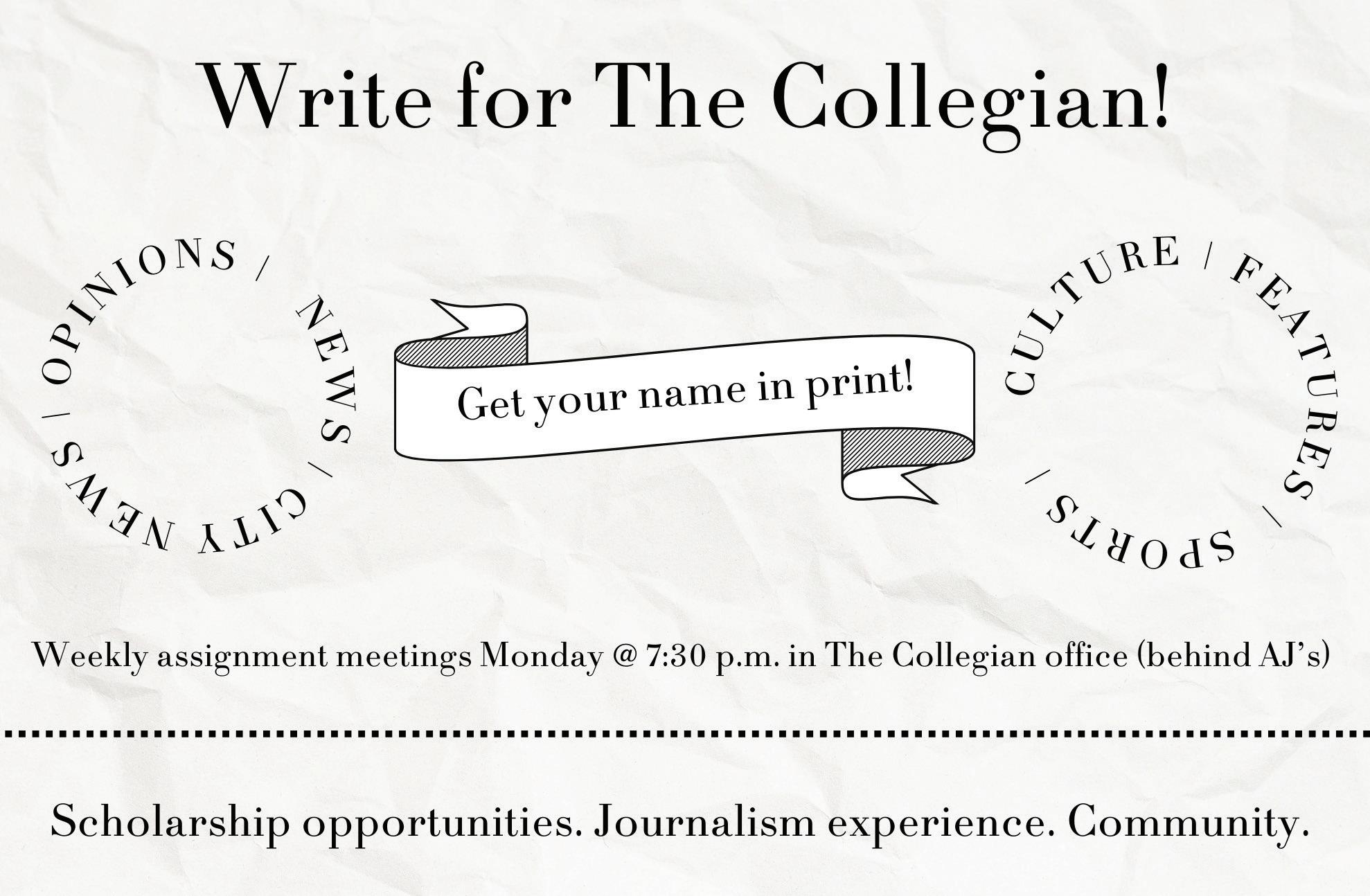
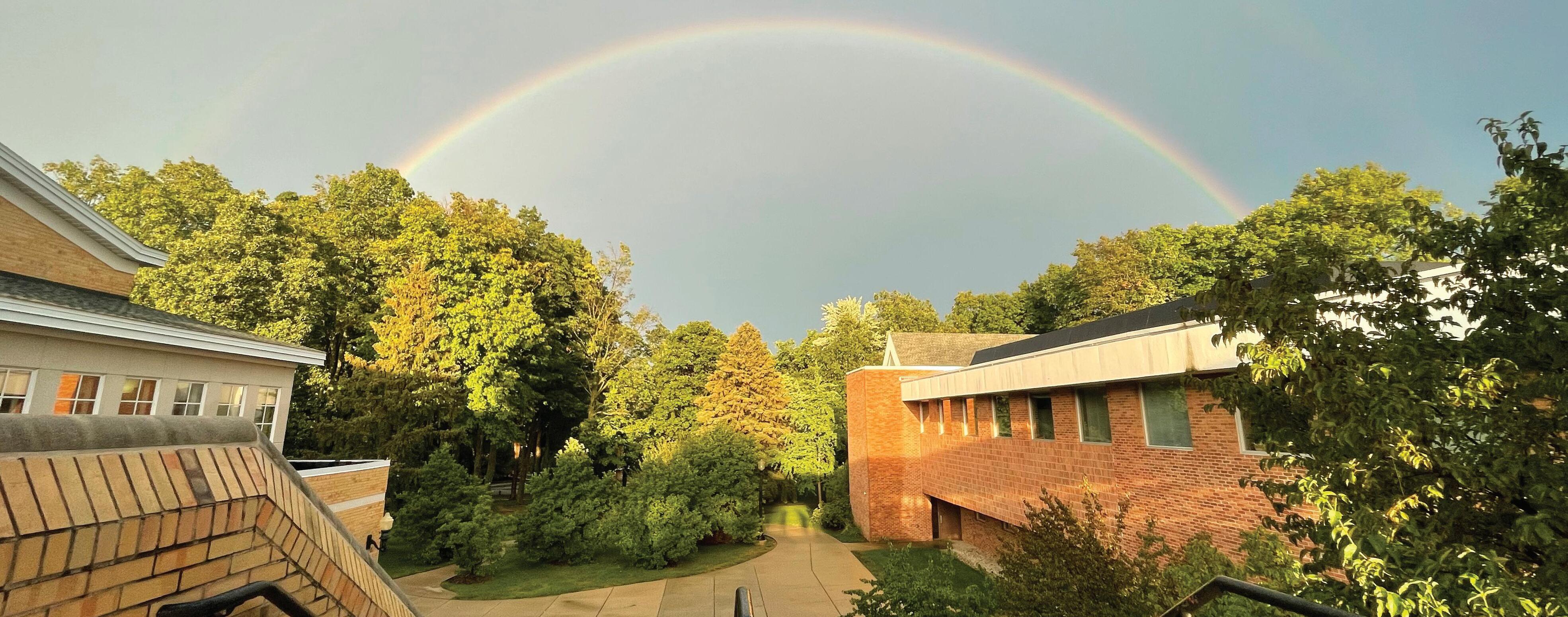
By Ty Ruddy ASSISTANT EDITOR
How can lifelong Coloradoans pick up, move to a small Midwestern town, and make it feel like home? How can Hillsdale College, a mere 400-acre campus in rural Michigan, bring the same joy as the busy streets of Ann Arbor or the cathedrals at South Bend? What are the makings of the perfect combination of friendship and home? A sibling.
Siblings are poison and nectar, kryptonite and a superpower, all wrapped in one.
For the Schmitt, Hutchinson, and Whalen families on Hillsdale’s campus, siblings are also colleagues.
“When he moved back, my wife and I were ecstatic. For me a sibling was coming home; for my wife, a great friend.
ere’s no slice of home like a sibling.”
“ is was never really the plan,” said Maria Servold, formerly Schmitt, assistant director of the Dow Journalism Program. “A er I graduated I worked as a reporter but was surprised and delighted to get the chance to come back to Hillsdale.” Servold and her brother Paul Schmitt, a rst-year as-
sociate professor of chemistry here at the college, are natives of Longmont, Colorado. Both attended Hillsdale College in the early 2010s.
“I knew I wanted to study chemistry, so it took some convincing, but Maria eventually got through to me,” Schmitt said. “I am thankful for the two years we spent together at the college.”
As with any sibling duo, their personalities and academic interests are not in total accord.
“I’m not sure I understand what he teaches,” Servold said. Schmitt agreed.
“I guess there’s a di erence between science minds and the minds that study English,” he added.
Servold said while they were on campus they would bicker about whose classes were harder.
“To end the debate I think we eventually agreed each class was hard in its own way,” Servold said.
A er graduation, Schmitt earned his Ph.D. in chemistry at Purdue University and later accepted a teaching position at Wabash College in Indiana.
A er some time, his big sister ran another campaign for Hillsdale College.
“We were both in the Midwest for what seemed like permanent careers, so I wanted Paul around Hillsdale again,” Servold said. “Since he was hired, the faculty has gradually found out that we’re related. It’s always fun to watch someone realize that he’s my brother.”
They now call Hillsdale home thanks to a mass migration of Schmitts from the Colorado mountains.
“Now our parents have moved from Colorado, and we see them almost every weekend. We call this ‘liv-
ing the dream,’” Servold said. “Paul and I both agree that 10 years ago we could have never imagined a life in the Midwest, but we are thankful. at’s the power of Hillsdale.”
Ryan Hutchinson, professor of mathematics, knows the draw of a sibling at Hillsdale. A er some time at the University of Michigan and the University of Notre Dame, Hutchinson settled down in Hillsdale because of his brother, Eric Hutchinson, chairman of the collegiate scholars program and associate professor of classics at Hillsdale College.
“My brother had been here for some time and when a math position opened, he encouraged me to apply,” Hutchinson said. “Now we work together and I get to watch his children grow up.”
With two sons teaching at

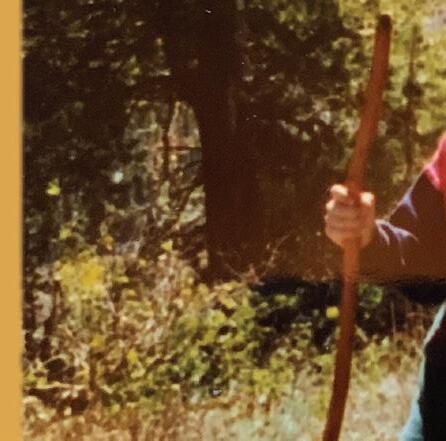


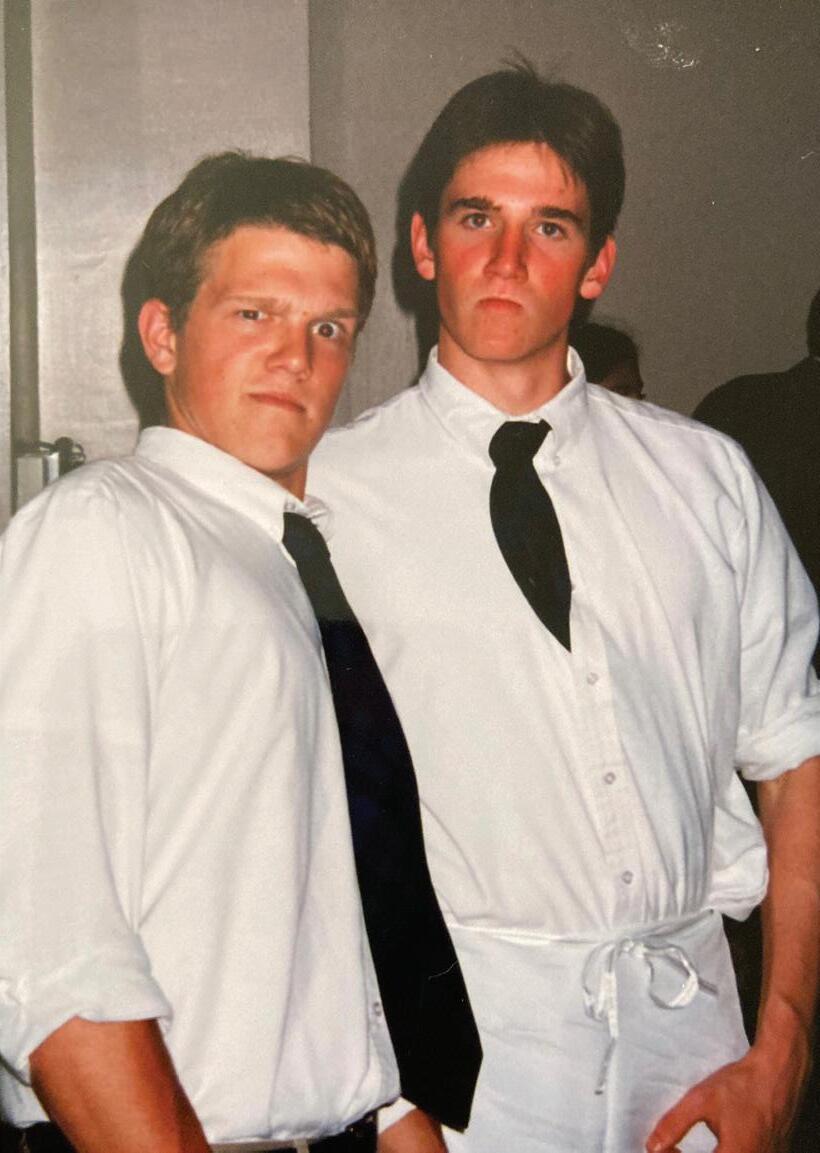

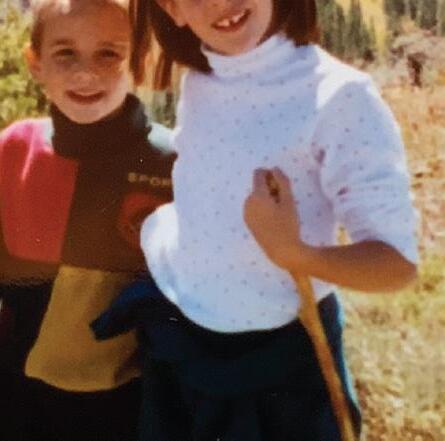


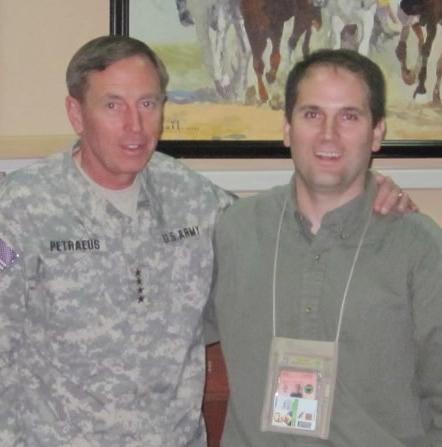

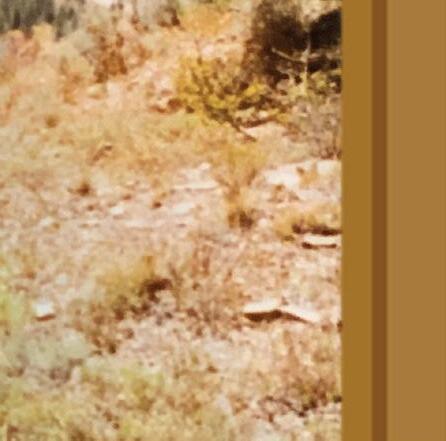

the same college, Hutchinson’s mother moved to Hillsdale County from Ida, Michigan.
“It’s a lucky situation,” Hutchinson said. “To work with a brother and to see him weekly is a blessing.”
Two of the members of the Whalen sibling clan also share Hillsdale’s campus: Benedict is an assistant professor of English. His brother Patrick, a Marine veteran, worked in the President’s O ce and now works with Hillsdale through American Classical Education, a charter school network a liated with the college.
“Patrick and I are number two and three in our large family so we did a lot of growing up together in close quarters,” Benedict Whalen said.
e two played on the same sports teams together in their younger years and eventually attended boarding school
together in Pennsylvania. Whereas most of the Whalens have only known Hillsdale as home, the older siblings remember the atlands of Kansas.
“It is a fun experience we older ones have,” Whalen said. “We have memories together that our other siblings don’t share. at and the small age gap brings us even closer.”
During Patrick’s deployment, his wife stayed for some time with Benedict and his wife. ey all grew close.
“By distance and the busyness of life, we did not see much of each other for those few years,” Whalen said. “When he moved back, my wife and I were ecstatic. For me a sibling was coming home, for my wife, a great friend. There’s no slice of home like a sibling.”


By Sydney Green COLLEGIAN REPORTER
In this Quick Hits, William P. Harris Chair of Military History Mark Moyar talks dad jokes, his favorite books, and his best advice for Hillsdale College students.
What is your favorite childhood memory?
Reading the “Brothers Karamazov.” It’s still my favorite book.
What is one piece of advice you would give to students?
e time you spend learning now will help prepare you for the hardships of the future.
What book are you reading right now?
“The Peacemaker: Ronald Reagan, the Cold War, and the World on the Brink,” by William Inboden. As a big Reagan fan, I would be reading it even if the Center for Military History and Strategy wasn’t hosting a talk by the author on Oct. 28.
What is an interesting fact about yourself?
My departure from the Trump administration was crazy enough that I wrote an entire book about it.
Do you have any hidden talents?
Embarrassing my children with middle-aged dad humor.
What is your favorite word?
Humility. Most of us need more of it
Who is one person you look up to?
Chairman and Associate Professor of History Korey Maas. It’s always a good idea to look up to the department chair.
What never fails to make you laugh?
“Beavis and Butthead.”
What do you wish you learned sooner?
Maintaining a positive outlook is vital to outward success as well as inner peace.
What trait most defines who you are?
Opposition to le ist orthodoxies.
If you could change one event in history, what would it be?
e Vietnam War. I have spent decades explaining how the United States could have prevailed had its presidents made better decisions.
What do you enjoy most about teaching?
Having in uence on the nation’s future leaders. Hillsdale graduates are becoming increasingly prominent in the nation’s a airs because of the college’s strengths as well as the decay of other elite educational institutions.